| ID |
Date |
Author |
Subject |
|
21
|
Fri Sep 25 12:58:33 2020 |
JM | Friday 25/09/20 |
10:00 Vessel P = 3.99e-8 mbar, RGA P = 1.4e-6 mbar
10:54 Vessel P = 3.89e-8 mbar, RGA P = 1.4e-6 mbar
Vessel continues to pump down. Baking Jacket fully installed and testing of baking begins before leaving on automatic mode for the week. Some baking jacket pieces may need to be re-jigged a little for use in GSI with the interaction chamber but will be fine for this bakeout. Note that due to the valves 'being in the way' the front of the baking volume holds the majority of the heaters
During this testing phase I have noticed the vessel pressure increase slightly even with vessel temperatures of approx 30C. Pvessel = 5.66e-8 mbar currently.
Automatic mode started 14:06. I will monitor to check everything is okay before letting it run over the weekend
16:00 I have noticed that two of the thermocouples floating(back) and floating(top) may be damaged as they were giving sharp spikes in temperature. I have just removed these thermocouples so they should just read the picologger temp. The jacket looks like it is holding temperature quite well. I have set the temperature to 35C and am currently waiting for temperatures to equillibriate before putting back into automatic mode. Pvessel = 1.68e-7 mbar
19:00 Temperatures look good, I will begin bakeout tomorrow morning now, so if anything goes wrong its not in the middle of the night. Have a good weekend all!
|
| Attachment 1: Photos.zip
|
|
22
|
Sat Sep 26 09:31:46 2020 |
JM, CB (both remotely) | Baking over weekend |
Sat 26 Sep
09:15 Baking started automatic mode
13:30 Baking continues, heating is slower than expected due to high chamber bottom temperatures
00:00 Baking stopped. Temperatures won't increase due to high temperature of the bottom of the chamber producing thermal gradients that are too high. I believe this is due to heaters being closer to the chamber as tray sits higher up than in previous test (see heaters.png). A shield above the heaters, similar to those we utilised in early tests in Edinburgh, may help to disperse the heat more evenly around the baking volume and not directly at the bottom of the chamber. I can improvise a shield similar to those using pieces of the aluminium outer layer of the baking setup I have spare on Monday and restart baking. This will also allow me to replace the two damaged thermocouples
Sun 27 Sep
11:50 Baking restarted. Manually set temperature to 50 C. Started automatic mode for additional safety checks. Will check again / increase temperature manually in a few hours
13:45 Found baking had stopped due to automatic mode detecting negative temperature gradient in TC7 Floating (bottom). See plot attached. Restarted baking at 50 C in manual mode
17:30 Found temperatures had stabilised. Increased temperature to 60 C. Issues seems to be that bottom thermocouples run hotter than the reference thermocouples of the RE72. The temperature the RE72 are set to maintain is not the temperature of the chamber. This is the cause of the strong gradients. Swapping the position of the thermocouples may be sufficient. Thermocouples presumed faulty on Friday may be working OK - could just be positioned in hot spot immediately above heaters.
18:00 Baking off to allow cooling down overnight. |
| Attachment 1: temps.png
|

|
| Attachment 2: temps2.png
|
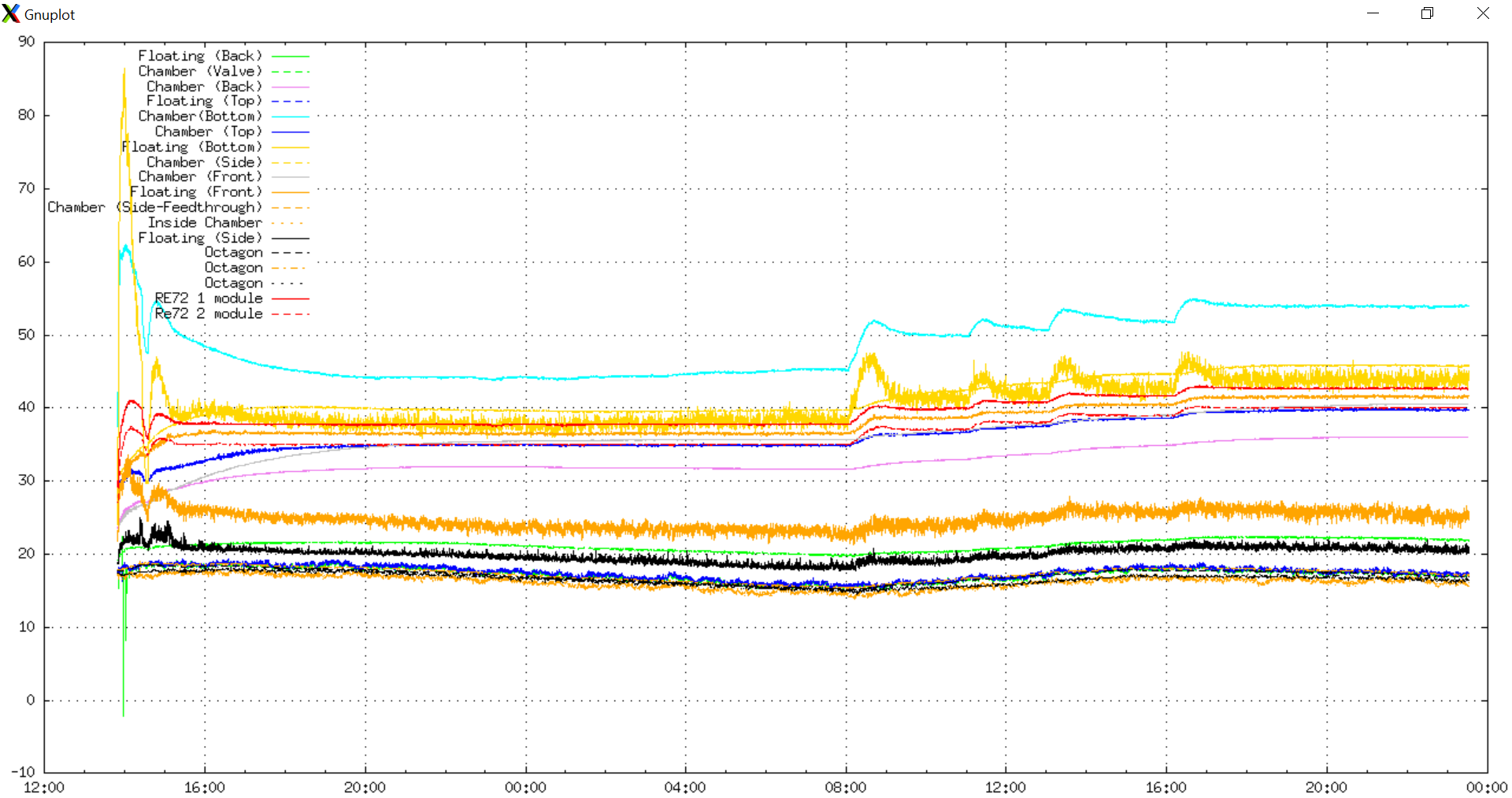
|
| Attachment 3: Heaters.jpg
|
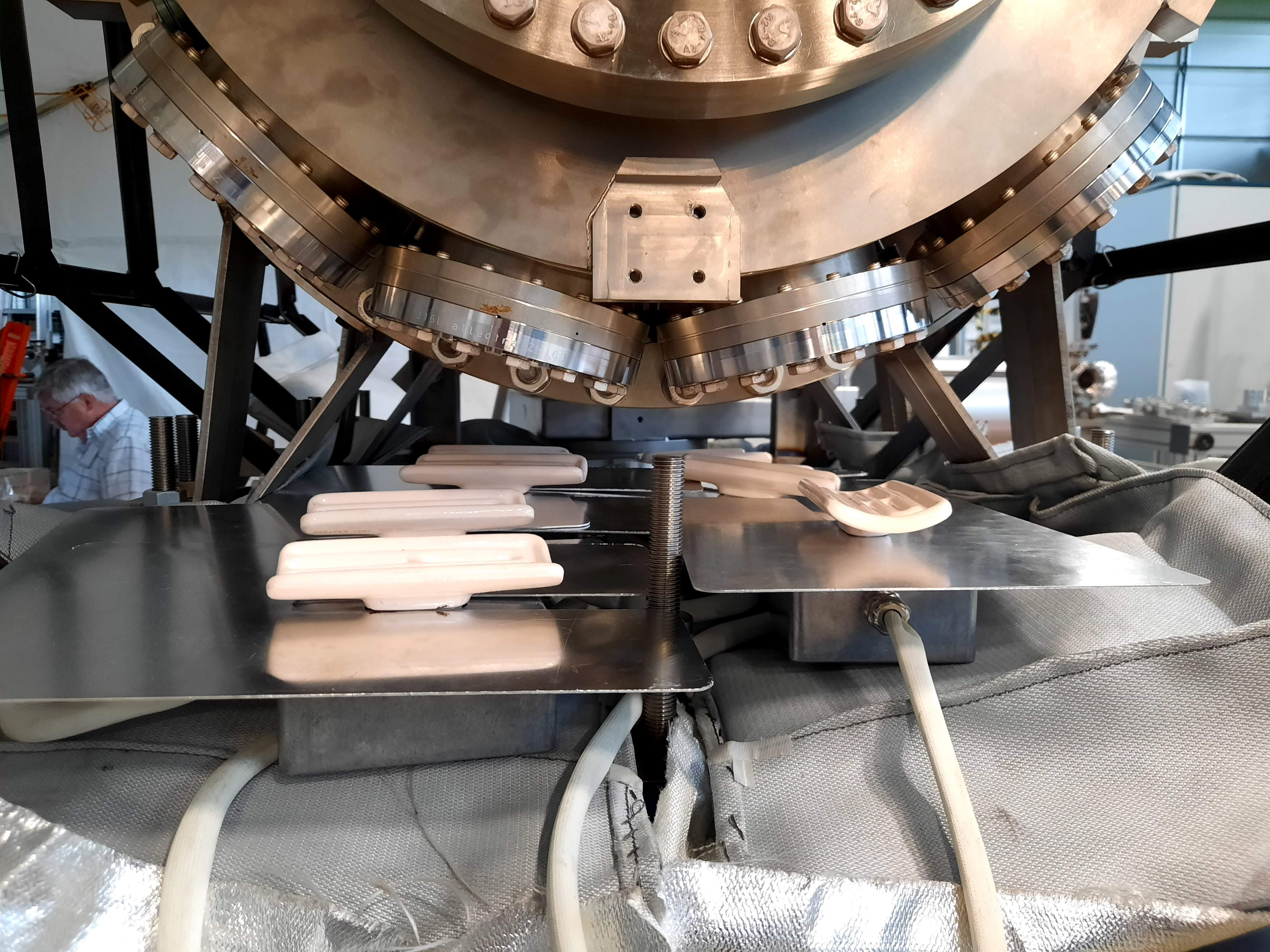
|
| Attachment 4: 20200927_1732_temps.png
|
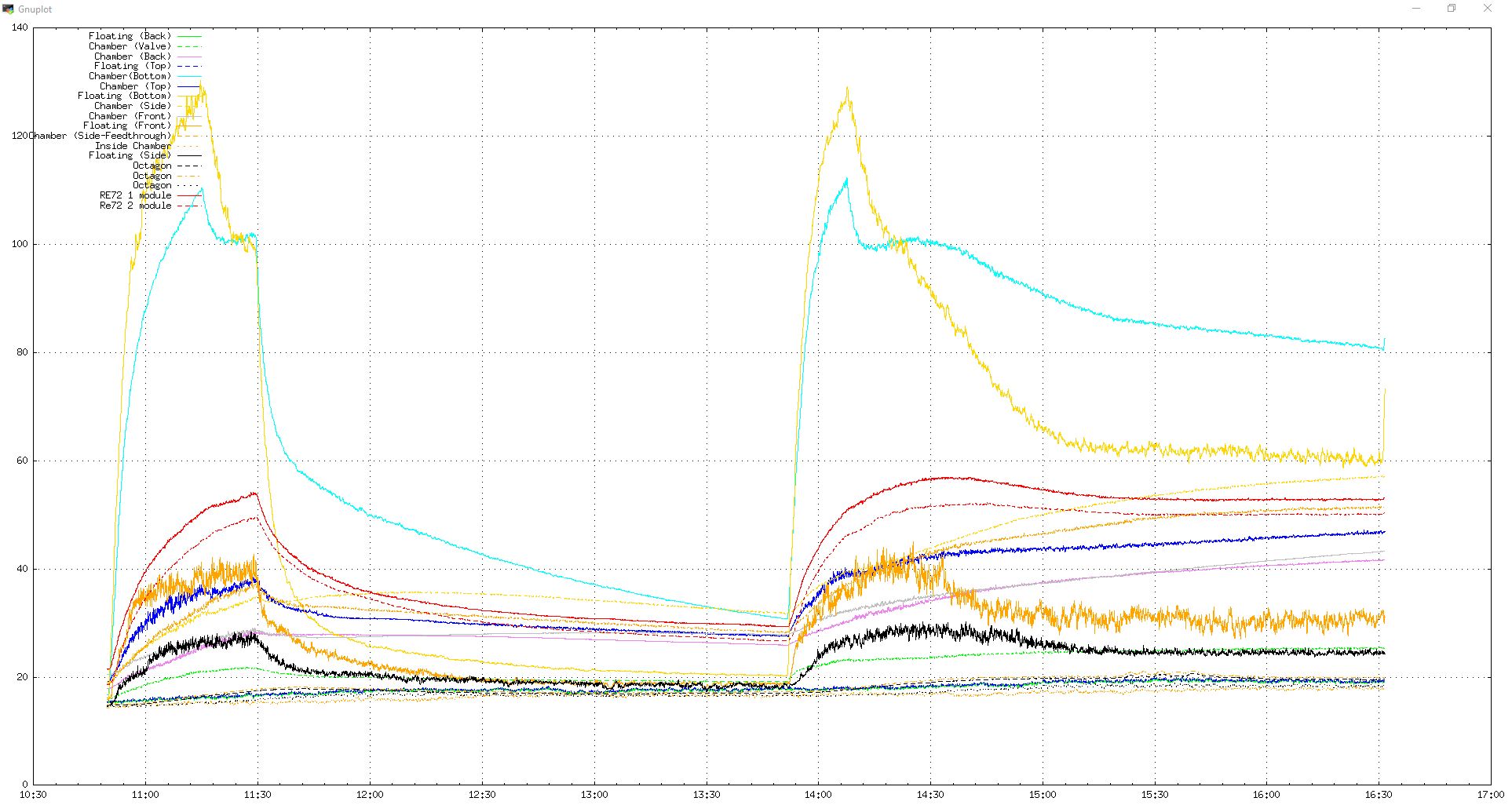
|
|
23
|
Mon Sep 28 13:04:27 2020 |
JM | Baking |
I have (fingers crossed) got the baking stepping up nicely now. I have used some of the outer shell to act as a shield and to direct airflow towards the front and back of the baking volume. I also moved the RE-72 thermocouples to a higher temperature region and replaced the broken thermocouples. The program is on automatic mode and has currently stepped up to 40C with the max diff reduced to ~4C.
I will continue monitoring for a bit but all looks good at the moment.
Additionally, our baking exploits over the weekend got us down to 9e-9 mbar when I came in this morning. |
| Attachment 1: 20200928_081831.jpg
|

|
| Attachment 2: 20200928_130239.jpg
|
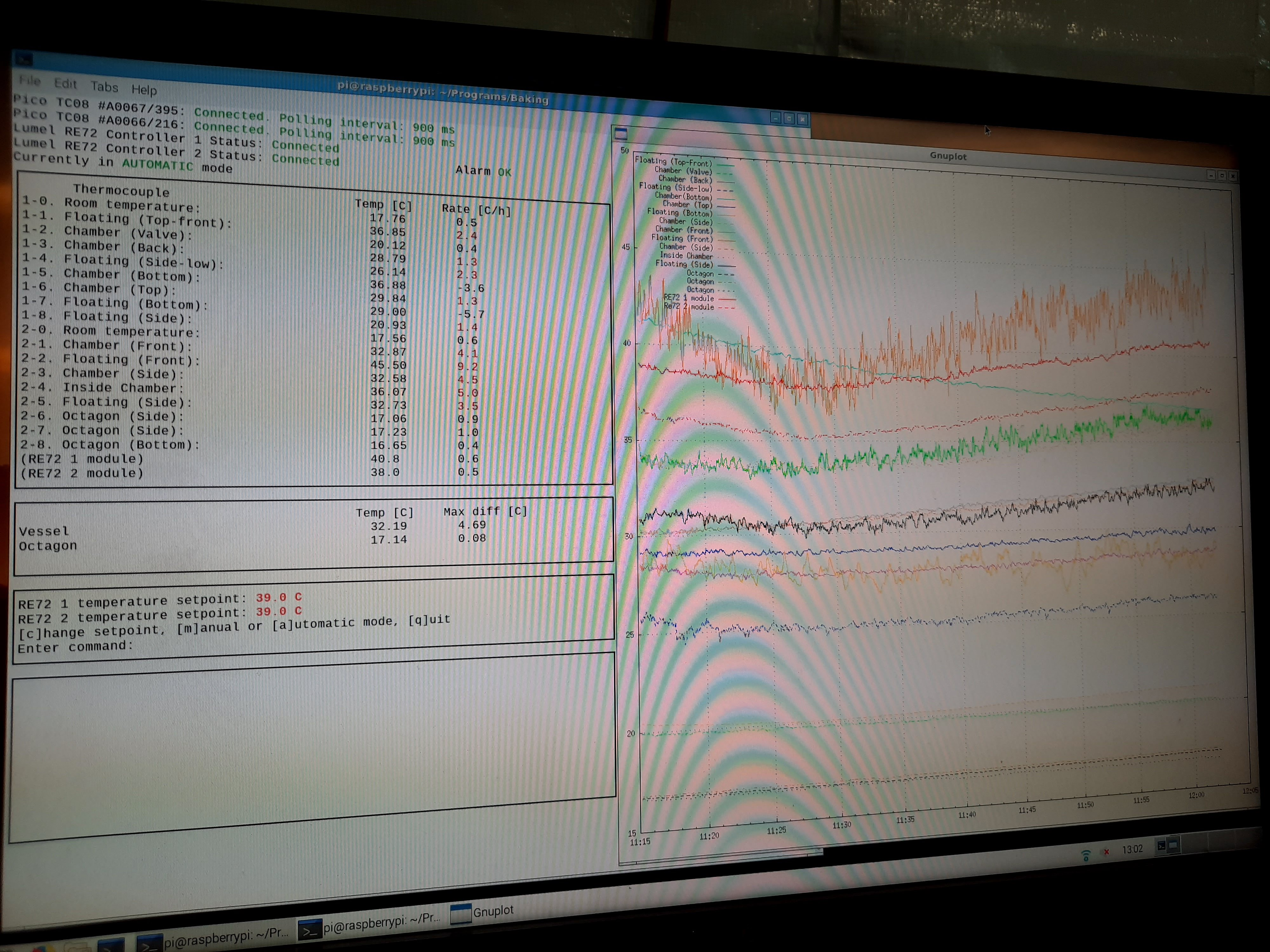
|
|
24
|
Wed Sep 30 08:10:36 2020 |
CB (remotely) | First bake of CARME with pumps |
(NOTE: Raspberry Pi internal clock appears to be on GMT, rather than GMT+1 due to daylight saving.)
Baking started on Mon 28 Sep. Due to WiFi connection authorisation expiring, no remote access was possible until
Tue 28 afternoon.
JM found remotely that temperature had increase up to 80 C, and baking had then been shut off due to negative
gradients. Unclear what happened. System was already cooling.
Restarted baking in automatic mode. Baking shut down automatically after few hours. It is likely the automatic
mode was being confused by vessel cooling and being heated at the same time.
29 SEP
20:30 Switched to manual mode (60 C). Left overnight
---
30 SEPTEMBER
08:10 Temperatures seem stable, but slight temperature gradient across vessel would prevent automatic mode from
working. See attached.
Unclear why RE72-1 let temperature reach 64 C when setpoint is 60 C. May be affected by RE72-2. Not worrying,
but may confuse automatic mode.
Ramped up to 70 C manually.
11:10 Temperatures stable. Ramped to 80 C manually. Gradient in CARME vessel unchanged at ~11 C. See attached.
14:18 Found baking had stopped shortly after last check. One floating thermocouple reported temperatures above 300 C.
Unclear what happened. Possible fault? See attached.
Restarted baking manually at 40 C. Waiting for temperature to stablise. Vessel still cooling - cannot activate
automatic mode.
15:00 Temperatures OK. Ramped manually to 50C
18:10 Temperatures stable. Ramped manually to 60 C. Left automatic mode on
20:20 Found temperature setpoint at 66 C. See attached.
Huge spikes in thermocouple 1-4 Floating (side-low). Same thermocouple that reported temperature spikes earlier. May be
faulty or touching heater directly. Seems to happen for T=65 C and above.
Set to manual mode. Temperature setpoint 60 C. Left overnight.
Will ask local people to remove thermocouple 4 from picologger 1 (aka #A0067/395, port 4) to continue.
---
1 OCTOBER
08:00 Temperatures stable. Interesting behaviour of problematic thermocouple 1-4. Trend looks real. Seems to confirm
hypothesis it is touching a heater.
Waiting for DL locals to disconnect it.
09:49 Thermocouple 1-4 disconnected. Increased temperature manually to 75 C / 70 C.
It appears RE72-1 consistently reports 5C above its set point. It controls 3 heaters vs. 8 heaters controlled by RE72-2.
This is most likely due to RE72-2 needing greater power output to reach its setpoint, increasing RE72-1 thermocouple
temperature as a result.
RE72-2 may be doing very little at the moment.
Hopefully placing its setpoint 5 C above will force both heaters to work together. This may decrease temperature
gradients observed in the vessel.
16:20 Increased temperature manually in steps up to 95 / 80 C.
The uneven temperature setpoints associated with the two RE72 appears to have reduced the temperature gradient in the vessel.
Will ramp up to 100 later this evening and leave overnight.
See attached.
22:00 Temperature stable. Rates are showing unphysical rates (too high / too low) and occasionally going all to zero at the
same time.
Looks like a previously observed bug that I thought had been sorted. Will have to debug again. Does not affect manual mode.
Ramped temperature to 105 / 95 C. Leaving overnight.
See attached.
---
2 OCTOBER
07:58 Temperatures stable. See attached. Slight gradient in CARME vessel (~11 C). Not worrying.
Ramped manually to 115 / 105 C
12:16 Temperatures stable. See attached. Valve temperature at 46 C.
Ramped manually to 125 / 115 C
17:34 Temperatures stable. See attached. We seem to be getting close to the upper limit of what the tent can achieve.
Ramped manually to 135 / 125 C
Will leave overnight.
---
3 OCTOBER
08:32 We have been baking at full power (heaters always on). Temperatures stable.
Appears to be as high as we can go with this tent configuration.
Will leave in manual mode and monitor throughout the day.
See attached.
17:00 Temperatures stable. No changes from this morning.
21:00 Temperatures stable. See attached. Baking continues overnight.
---
4 OCTOBER
07:30 Found temperatures decreased overnight by around 10 C. See attached.
We are still baking at full power. Room temperature has not changed.
Most likely explanation is part of the tent giving / moving due to the baking and a draft being developed.
Will keep monitoring during the day.
13:50 Temperatures stable, no changes from last check.
20:22 Temperatures stable. See attached. Leaving overnight. |
| Attachment 1: 20200930_0810_ctrl.png
|
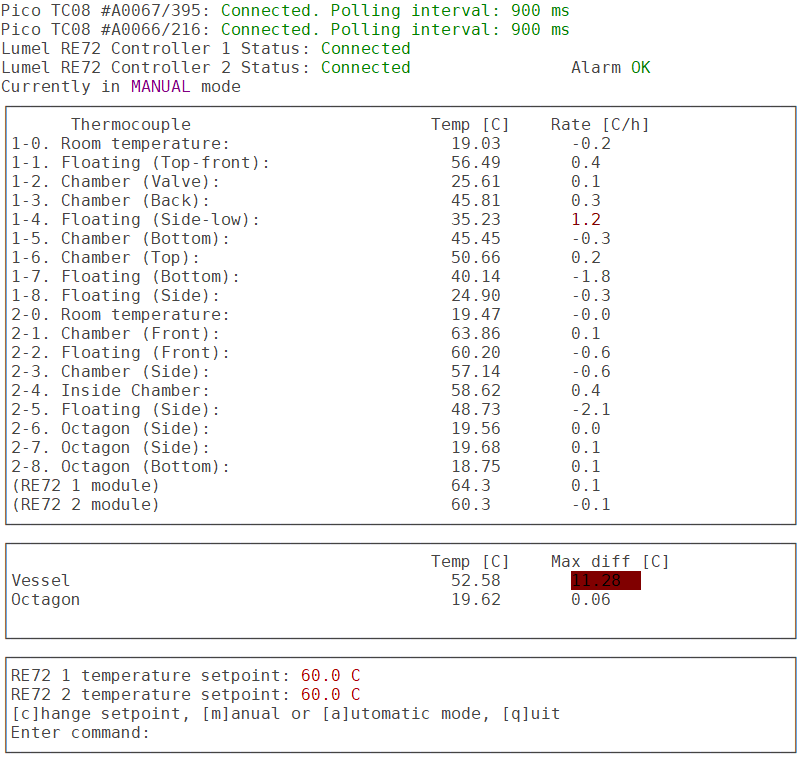
|
| Attachment 2: 20200930_0810_temps.png
|
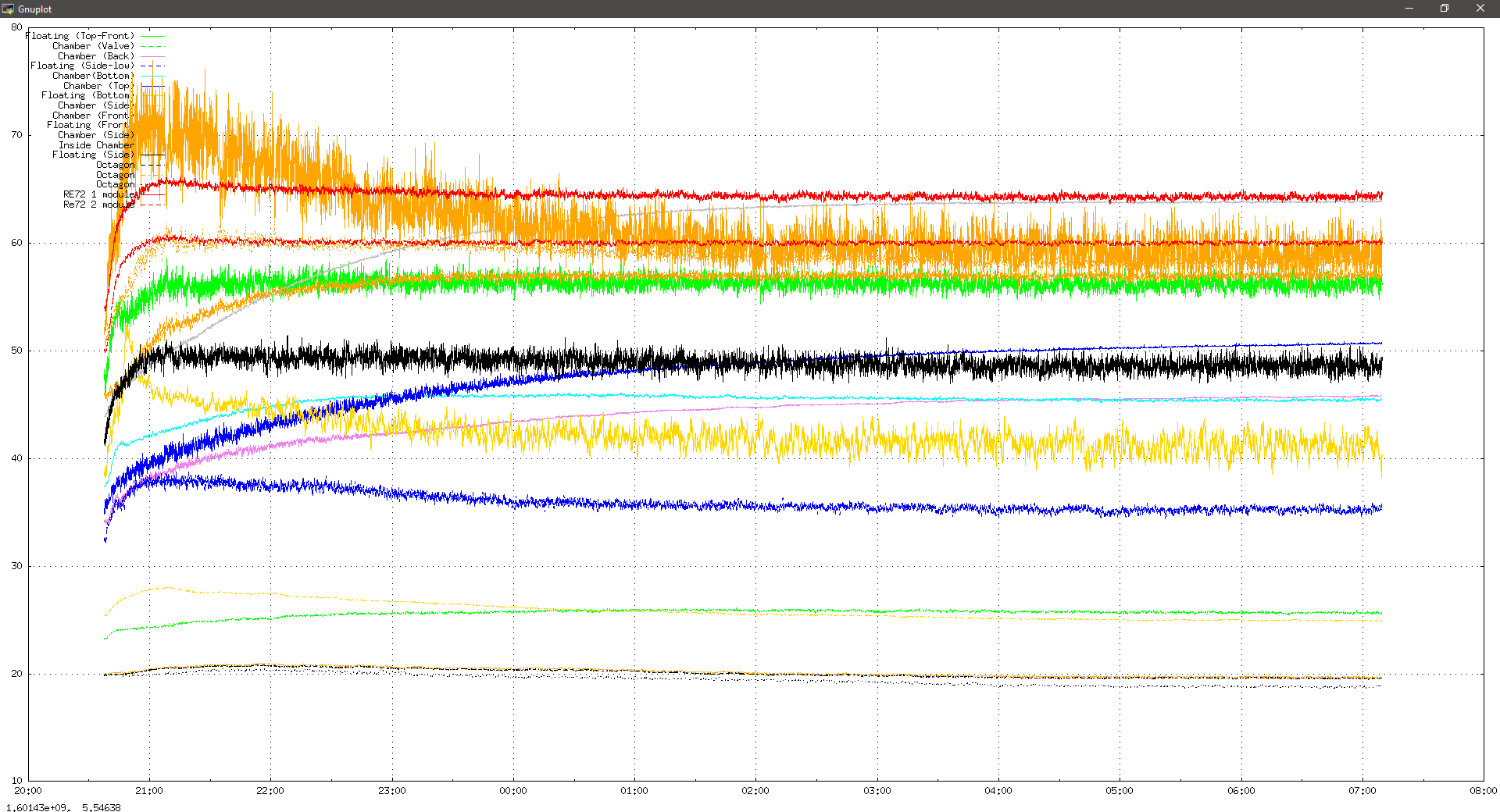
|
| Attachment 3: 20200930_1112_temps.png
|
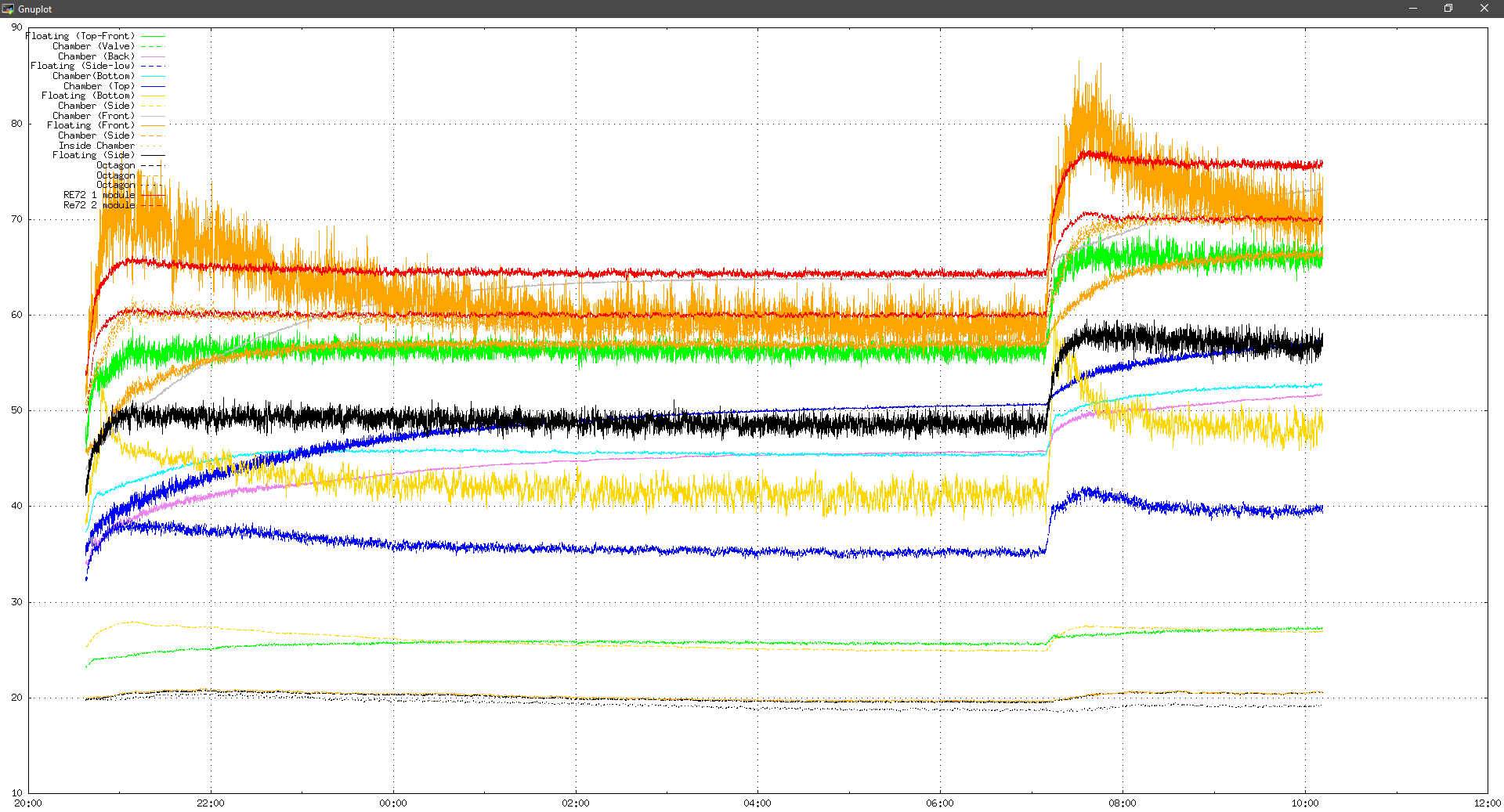
|
| Attachment 4: 20200930_1419_temps.png
|

|
| Attachment 5: 20200930_2031_ctrl.png
|

|
| Attachment 6: 20200930_2031_temps.png
|
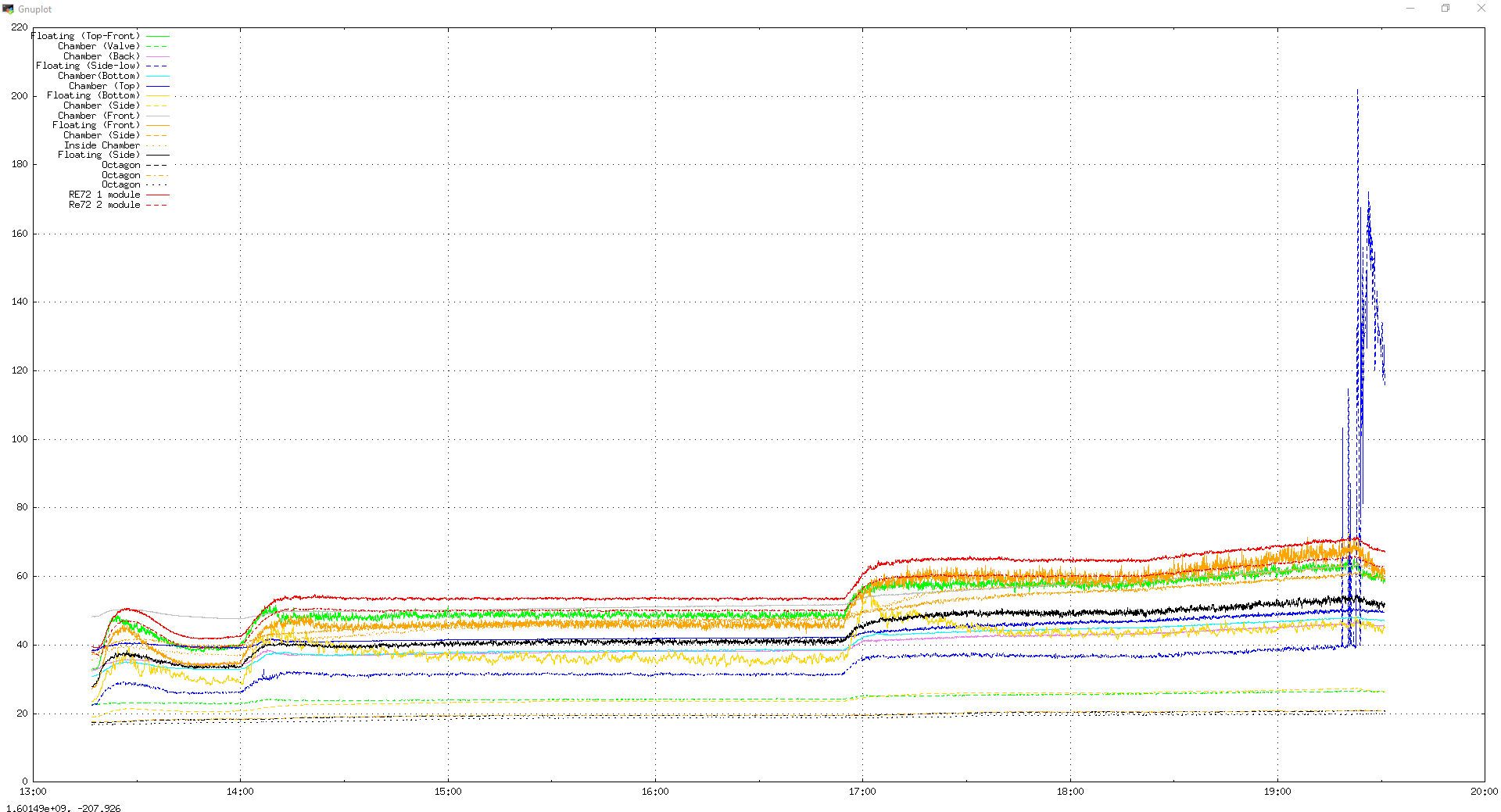
|
| Attachment 7: 20201001_0800_temps.png
|
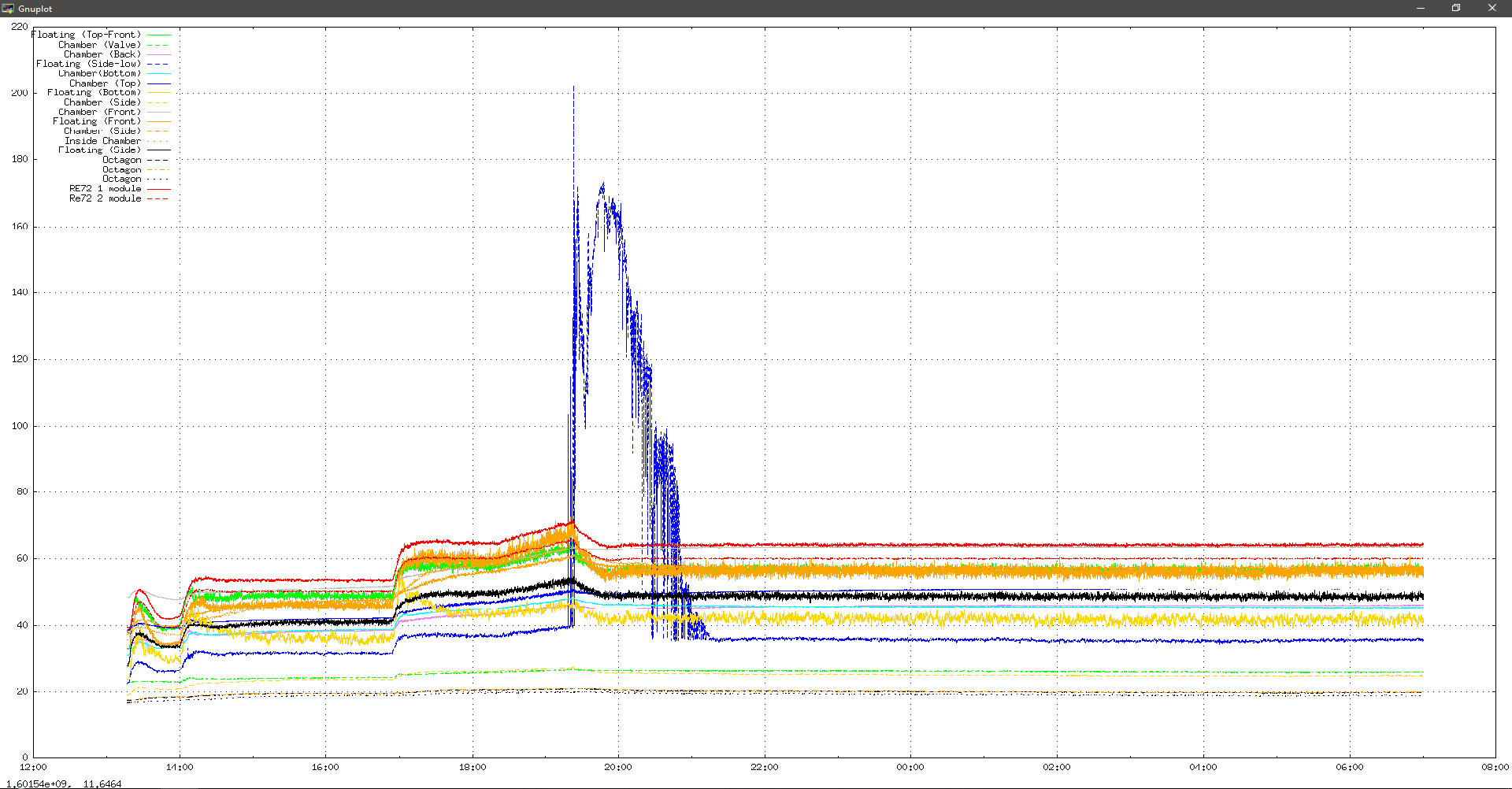
|
| Attachment 8: 20201001_1620_ctrl.png
|

|
| Attachment 9: 20201001_1620_temps.png
|
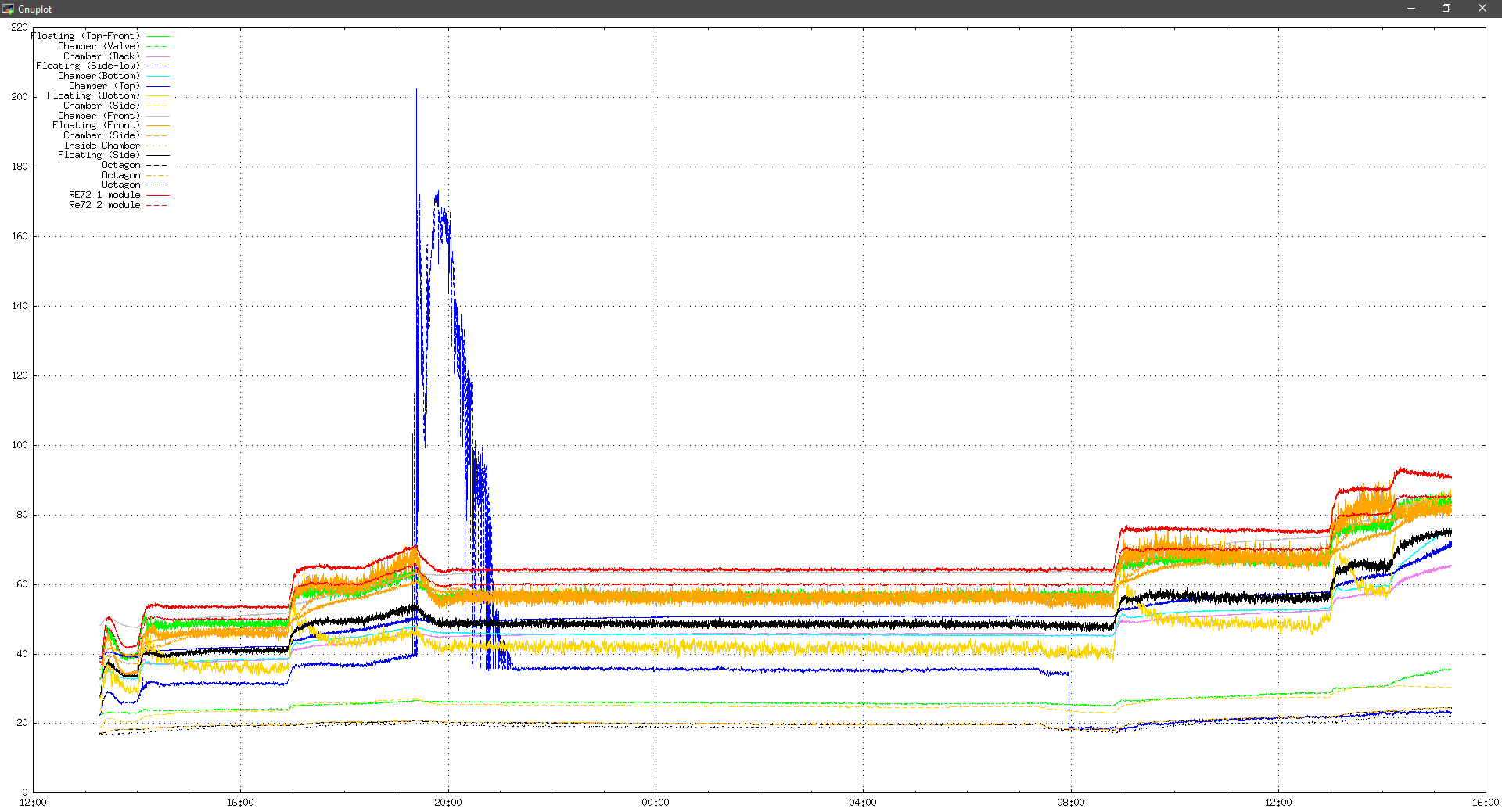
|
| Attachment 10: 20201001_2200_temps.png
|

|
| Attachment 11: 20201002_0757_temps.png
|

|
| Attachment 12: 20201002_1215_ctrl.png
|

|
| Attachment 13: 20201002_1215_temps.png
|

|
| Attachment 14: 20201002_1732_ctrl.png
|
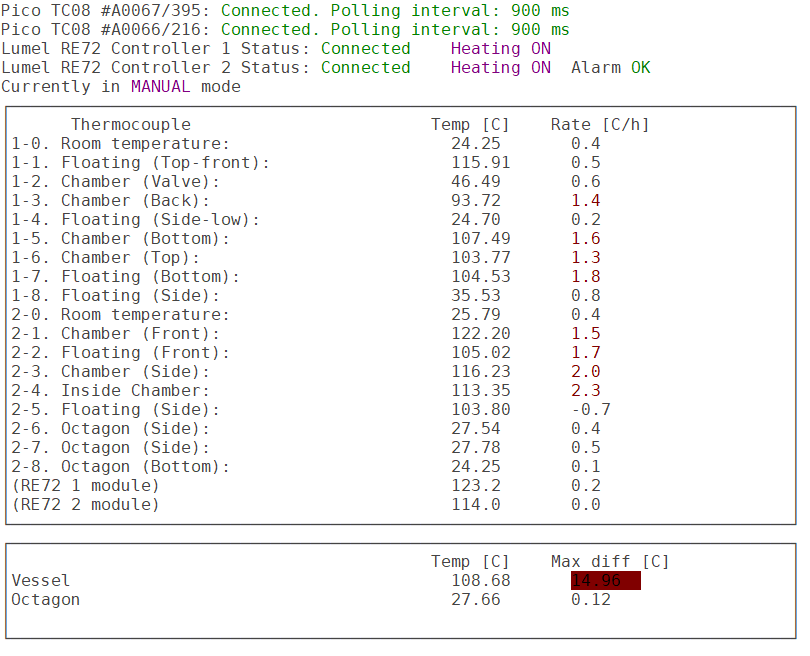
|
| Attachment 15: 20201002_1732_temps.png
|

|
| Attachment 16: 20201003_0833_temps.png
|
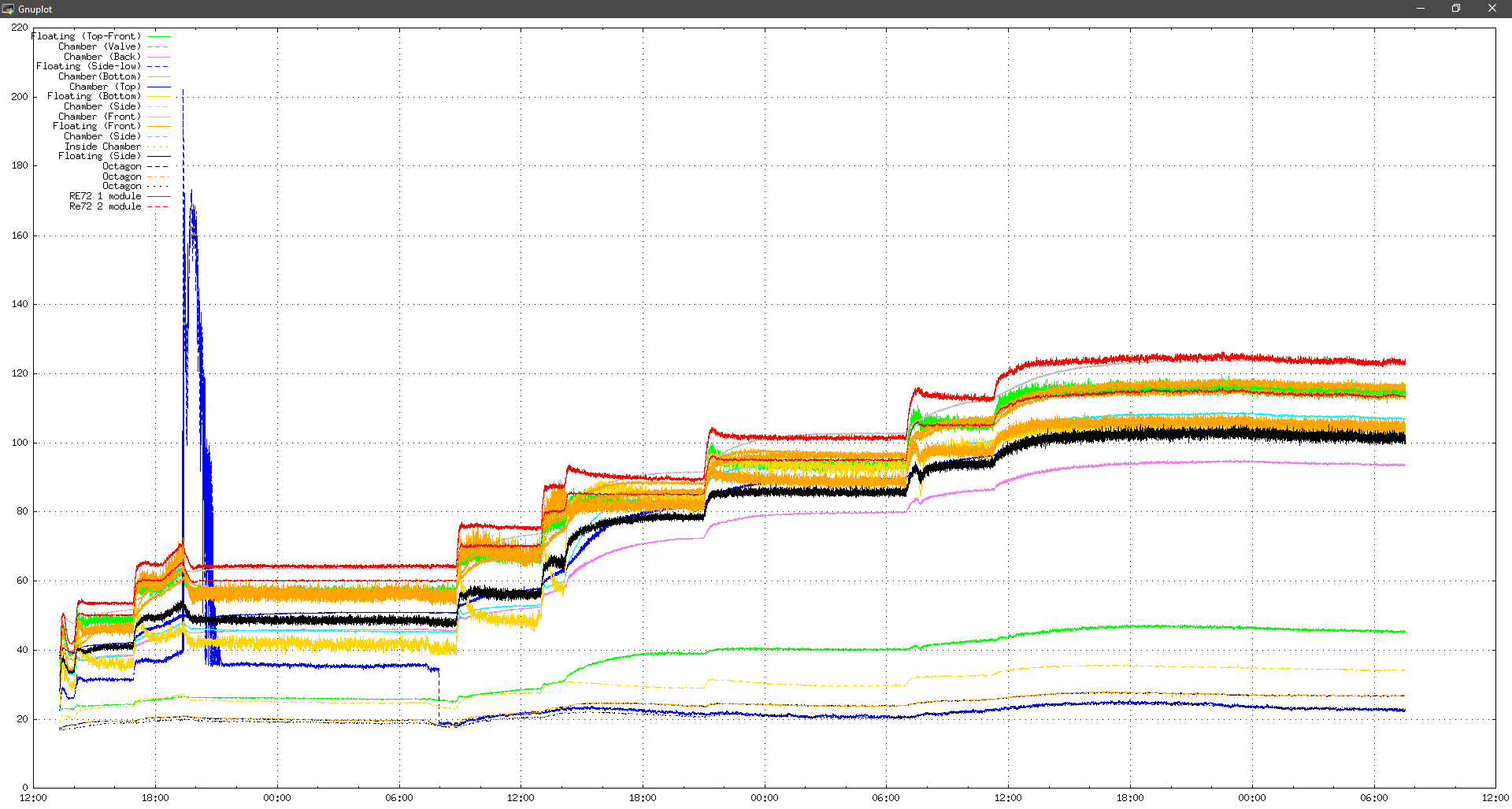
|
| Attachment 17: 20201003_2100_temp.png
|

|
| Attachment 18: 20201004_0732_temps.png
|

|
| Attachment 19: 20201004_2021_temps.png
|

|
|
25
|
Mon Oct 5 08:21:40 2020 |
CB (remotely), JM | First bake of CARME with pumps (cont.) |
5 OCTOBER
08:21 Temperatures stable overnight. See attached. Baking continues.
Remember to visually inspect the tent for potential new drafts the next time in Daresbury.
Also remember to check on thermocouple 1-4 status / position.
10:15 Draft caused by section of top blanket collapsing slightly producing a hole at the top-back end of the volume. Only way to remove draft is to power down and shift
some of the larger blanket sections over to support the collapsed bit. Keith requires temperatures >120C for the vessel average to proceed so heat was powered down and
jacket reconstructed. See attached photos of the top of the baking volume (Sorry for quality).
Pressure on vessel when baking concluded: 2e-7mbar
13:00 Baking jacket all sorted, temperature set to 60C to equilibrate. New session had to be started as cooling then heating confuses the rates on the baking program. All
looks good at the moment, will continue to monitor and increase temperature when needed. Automatic mode may be able to be utilised again as rectifying the insulation on
the
back has reduced the thermal gradients somewhat.
Pressure on vessel when baking restarted: 1e-8 mbar
Bumax order has also been delivered
16:00 Monitoring remotely, bakeout has been on automatic for an hour and is currently at 67C. Vessel gradient ~7.5C
17:15 All looks okay, will leave for a few hours now. Temp is 73C, gradient ~8.2C
22:00 Automatic baking to 90C gradient >10C. Ramped to 105C for RE72-1 and 100C for RE72-2. Will leave overnight to stabilise
6 October
9:50 Temperatures stable, increasing to 115C, 105C
11:20 Temperatures stable, Increasing to 120C, 115C
13:15 Temperatures stable, increasing to 125C, 120C. Vessel average ~115C.
14:45 Temperatures stable (see attached). Increasing to 130C, 125C. Vessel average~120C
20:16 Temperatures stable, may be getting to edge of how hot we can get. Increasing to 135C, 130C overnight. Vessel average~128C should be sufficient.
7 October
07:30 Temperatures stable, have reached max temperature we can achieve 132C, 128C on RE-72 thermocouples. Vessel average~131C should be sufficient. Temperatures will be
maintained until Monday when negs can be activated.
20:30 Temperatures stable (see attached)
8 October
10:30 Temperatures stable
9 October
8:30 Temoeratures remain stable |
| Attachment 1: 20201005_0821_temps.png
|

|
| Attachment 2: 20201005_110422.jpg
|

|
| Attachment 3: 20201005_134003.jpg
|

|
| Attachment 4: temps3.png
|
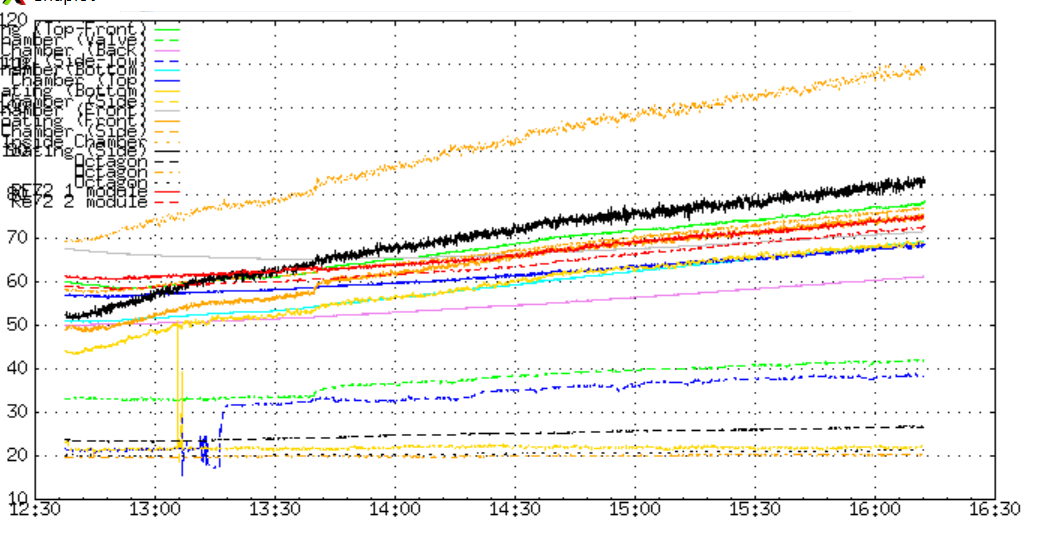
|
| Attachment 5: temp4.png
|

|
| Attachment 6: temp5.png
|
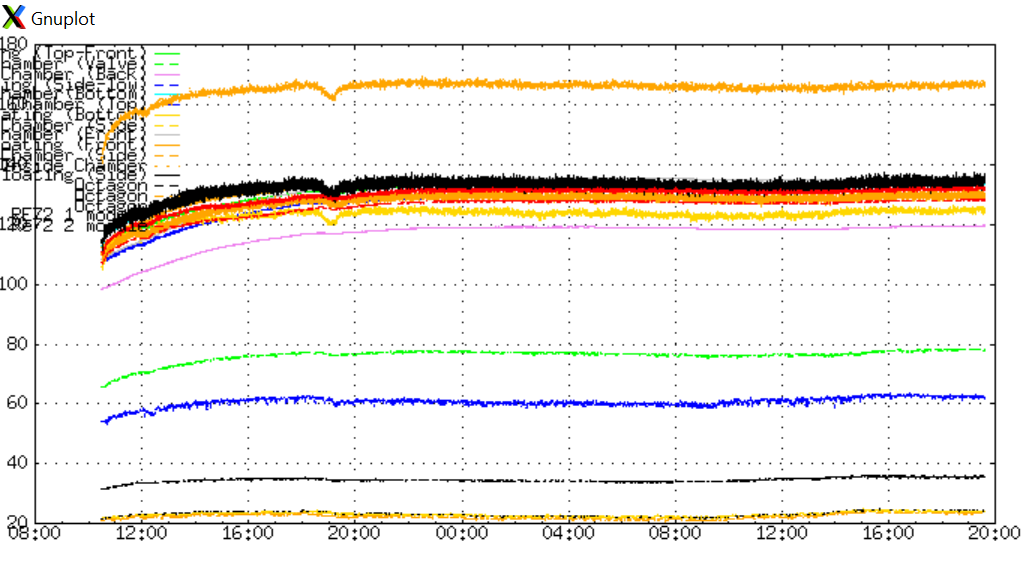
|
|
26
|
Mon Oct 12 10:49:36 2020 |
JM | First Bakeout of CARME with pumps (cont) |
12 October
10:00 Bakeout temperatures stable. Pressure on the backing line is 3e-7mbar which is the lowest we have achieved on the backing line so far. Vessel pressure can't be measured at the moment as temperature exceeds the max operational temperature of 80C.
14 October
11:30 Bakeout temperatures stable. Slight day/night cycle can be seen and a ~2-3C dip over the weekend, probably due to heating in ETC turning off at night and over the weekend. Vessel average remains ~130C. Pressure in the backing line dropped to 2.5e-7mbar. EU plug Adapters have been delivered, waiting on leads to begin activation of NEG pumps. |
| Attachment 1: temp6.png
|

|
|
27
|
Mon Oct 19 13:57:52 2020 |
JM | Neg Activation |
Neg and Neg-Ion pumps have been connected up to the control modules. Controller on the right is connected to the D-2000s. Middle controller is connected to the wall section negs (1x2negs in series and 1x3negs in series) and the moving detector negs (2x2 negs in series). Left controller is connected to the intermediate section negs (2x2 negs in series). Must connect IN/OUT interface on the back of the controller or the alarm for an open circuit is triggered. When no thermocouple is connected Tmax must be set to zero otherwise the thermocouple alarm is triggered.
13:00 Pressure on chamber= 6e-9mbar
13:55 I have begun ramping up the middle controller. Ramp time is 45 minutes, slightly longer than the recommended 15-30 mins in the manual to see how well vaccum reacts. Controller will hold maximum power for one hour for activation. Controller has 4 outputs, one for each neg cable. Outputs 1-3 are the 2 negs in series, output 4 is the 3 negs in series. Parameters for outputs 1-3 are; Vmax=100V, Imax=5A, Pmax= 400W. Parameters for output 4 are; Vmax=110V, Imax=5A, Pmax=600W.
14:05 Pressure chamber = 1.92e-6mbar. Power per output is 60, 78, 79, 87 W.
14:15 Pressure chamber = 2.4e-6mbar. Power per output is 114, 148, 150, 168 W.
14:25 Pressure chamber = 1.44e-6mbar. Power per output is 201, 261, 264, 300W.
14:35 Pressure chamber = 1.12e-6mbar. Power per output is 305, 398, 397, 466W
14:56 Pressure chamber = 1.52e-6mbar. Negs are on max power and are holding for an hour.
15:45 Intial activation completed. Negs have been set to half power to maintain temperature at ~200-250C. Parameters set for outputs 1-3; Vmax= 50V, Imax=5A, Pmax=200W. Parameters set for output 4; Vmax=70V, Imax=5A, Pmax=300W. Pressure on the chamber is now 4.4e-8mbar. The pressure tomorrow morning should tell us if the activation has been successful, afterwhich I will activate the next lot of negs. Average vessel temperature is now 146C. I believe our 'internal thermocouple' isn't reading the internal temp after all and is just the temperature of the bottom feedthrough flange, as its temp maxed out at 175C and followed a similar gradient to the other vessel thermocouples. See attached temperature plot.
20 October
08:30 Pressure on the vessel = 2e-8mbar. Pressure hasn't dropped significantly probably due to negs maintaining a temperature of 200-250C causing significant outgassing. Chamber temperature has maintained at 145C so outgassing from chamber will also have increased also.
08:45 2nd set of negs activated. Intermediate chamber negs activated (2x 2 negs in series) which are connected to outputs 3+4 on the left controller. Parameters for outputs; Vmax=100V, Imax=5A, Pmax=400W, Rise time= 30mins, Hold = 60mins.
First set of negs remains at half power.
Pressure on the vessel =8e-8mbar
08:55 Pressure on vessel = 1e-6mbar. Outputs; V=74, 74W I=2.2, 2.2A P=79, 79W
09:05 Pressure on vessel = 2.2e-7mbar. Outputs; V=58,58V I=3,3A P=175,175W
09:10 Pressure on vessel = 3e-7mbar. Outputs are; V=79,79V I=3.7A P=300,300W.
09:20 Pressure on vessel = 1.2e-6mbar. Outputs are; V=100V, I=4A, P=400W. Negs are now on hold for the hour activation. Chamber temperatures are stable at ~145C still
10:45 Negs are being held at half power to maintain temperature. All that is left is the D2000's on Thursday. Pressure in the vessel is staying constant at ~8e-8mbar. Chamber temperatures ae stable at ~145C.
|
| Attachment 1: Photos.zip
|
| Attachment 2: 20201019_154921.jpg
|

|
|
28
|
Thu Oct 22 10:39:40 2020 |
TD | Thursday 22 October |
10.40
CARME chamber 2.84e-08mbar
Backing 1.2e-7mbar (Edwards vacuum cart w/RGA)
CARME temps - see attachment 1
vessel 146.62 deg C max diff 21.42 deg C
octagon 27.85 deg C max diff 6.35
SAES HV power modules - see attachments 2-12
14.00
CARME chamber 2.78e-08mbar
Start 4x SAES D2000-10 *NEG* pumps (ion pump OFF) - see attachments 13-18
Ramp 45 mins
Hold 60 mins
225W/550deg C
NEG pumps report temps c. 130 deg C
14.15 ramp
CARME chamber 2.0e-07mbar
Backing 3.3e-07mbar (Edwards vacuum cart w/RGA)
NEG pump temps c. 230-250 deg C
14.30 ramp
CARME chamber 2.34e-07mbar
Backing 4.1e-07mbar (Edwards vacuum cart w/RGA)
NEG pump temps c. 330-350 deg C
14.45 ramp
CARME chamber 4.02e-07mbar
Backing 4.1e-07mbar (Edwards vacuum cart w/RGA)
NEG pump temps c. 450-455 deg C
15.00 hold
CARME chamber 4.56e-07mbar
Backing 5.7e-07mbar (Edwards vacuum cart w/RGA)
NEG pump temps c. 500-505 deg C
output c. 50V, c. 3A, c. 150W
15.20 hold
CARME chamber 4.40e-07mbar
Backing 5.1e-07mbar (Edwards vacuum cart w/RGA)
NEG pump temps c. 530-540 deg C
output c. 160-170W
15.40 hold
CARME chamber 3.46e-07mbar
Backing 4.3e-07mbar (Edwards vacuum cart w/RGA)
NEG pump temps c. 540-545 deg C
output c. 160-170W
15.50 cycle complete
Ramp 45 mins
Hold inf mins
set output 60W
re-start CARME bakeout
set point +120 deg C
15.55 ramp
CARME chamber 5.15e-08mbar
Backing 1.4e-07mbar (Edwards vacuum cart w/RGA)
NEG pump temps c. 350-360 deg C
16.15 ramp
CARME chamber 4.53e-08mbar
Backing 1.5e-07mbar (Edwards vacuum cart w/RGA)
NEG pump temps c. 260-270 deg C
16.17 CARME chamber temperatures - attachment 20 |
| Attachment 1: 20201022_104309.jpg
|
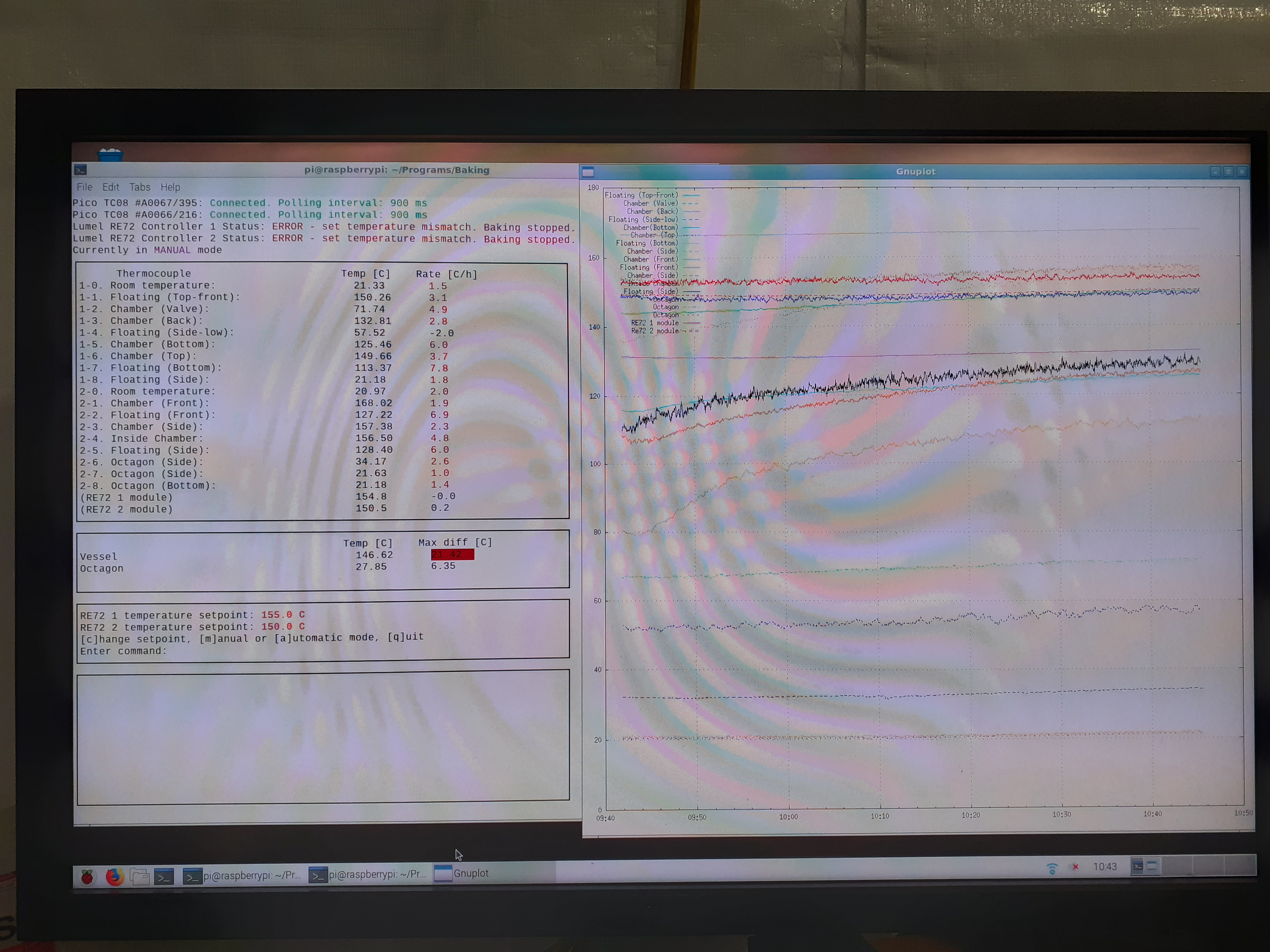
|
| Attachment 2: 20201022_104331.jpg
|

|
| Attachment 3: 20201022_104339.jpg
|

|
| Attachment 4: 20201022_104345.jpg
|
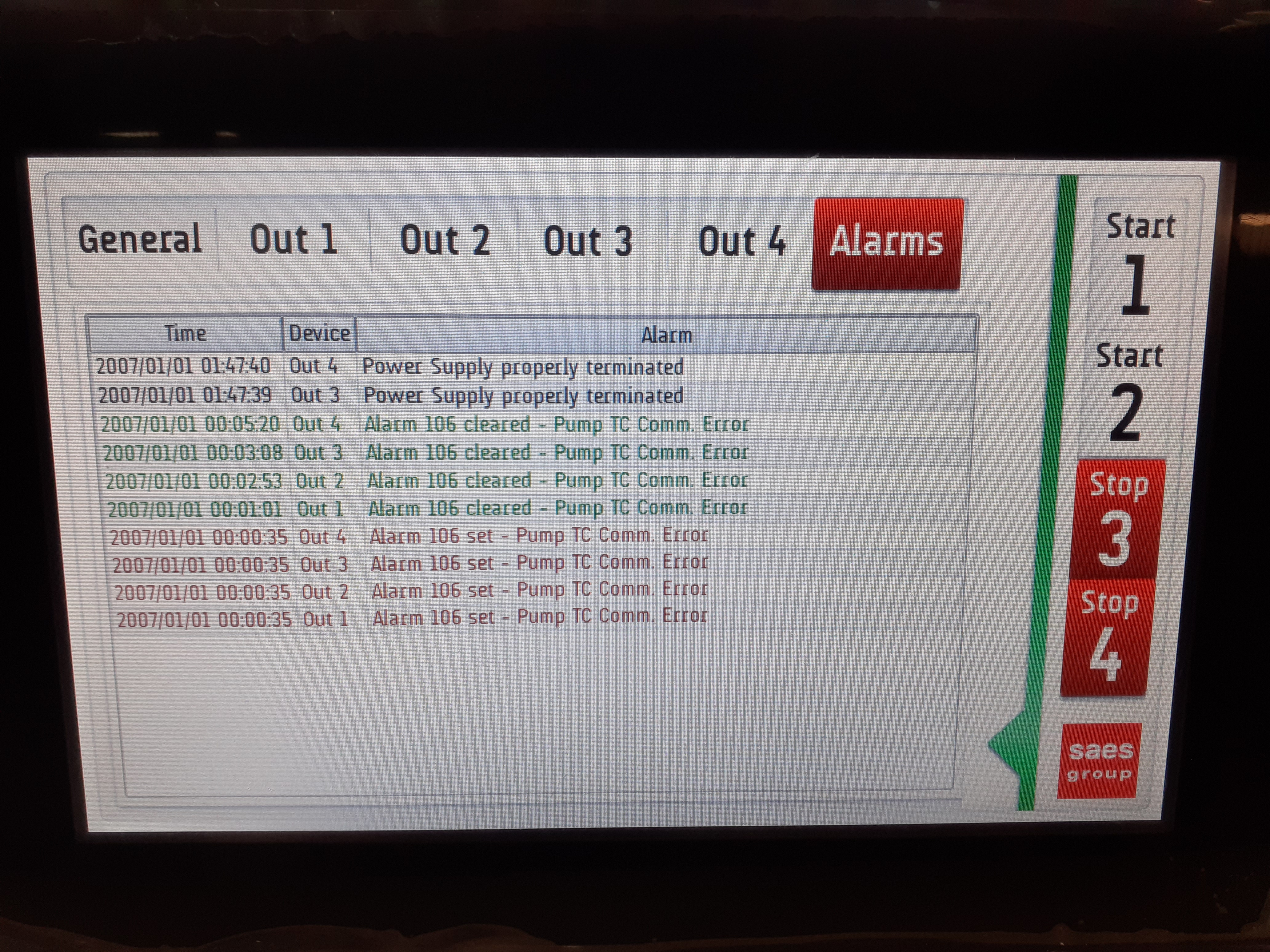
|
| Attachment 5: 20201022_104354.jpg
|

|
| Attachment 6: 20201022_104354.jpg
|
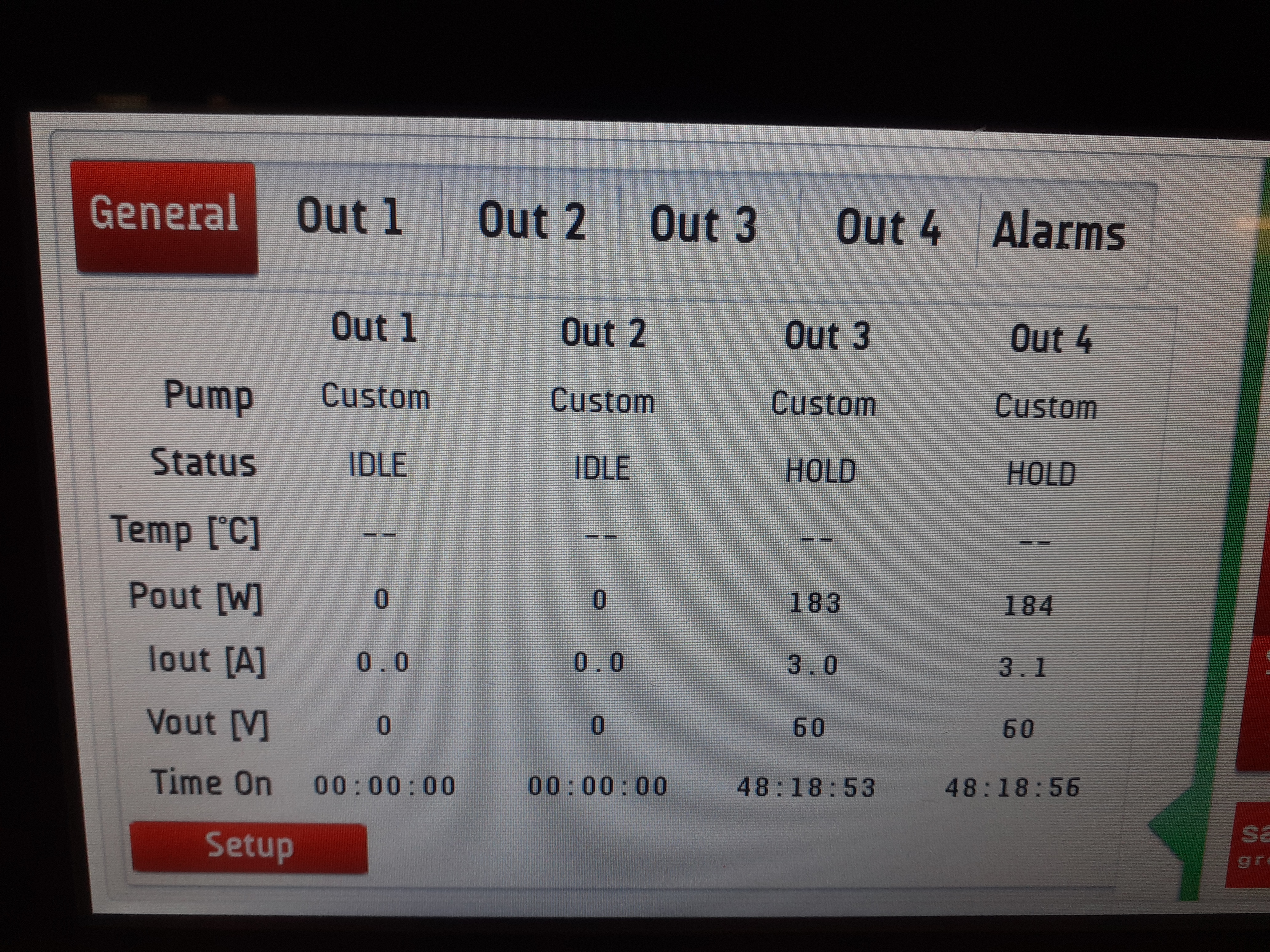
|
| Attachment 7: 20201022_104412.jpg
|

|
| Attachment 8: 20201022_104415.jpg
|

|
| Attachment 9: 20201022_104419.jpg
|
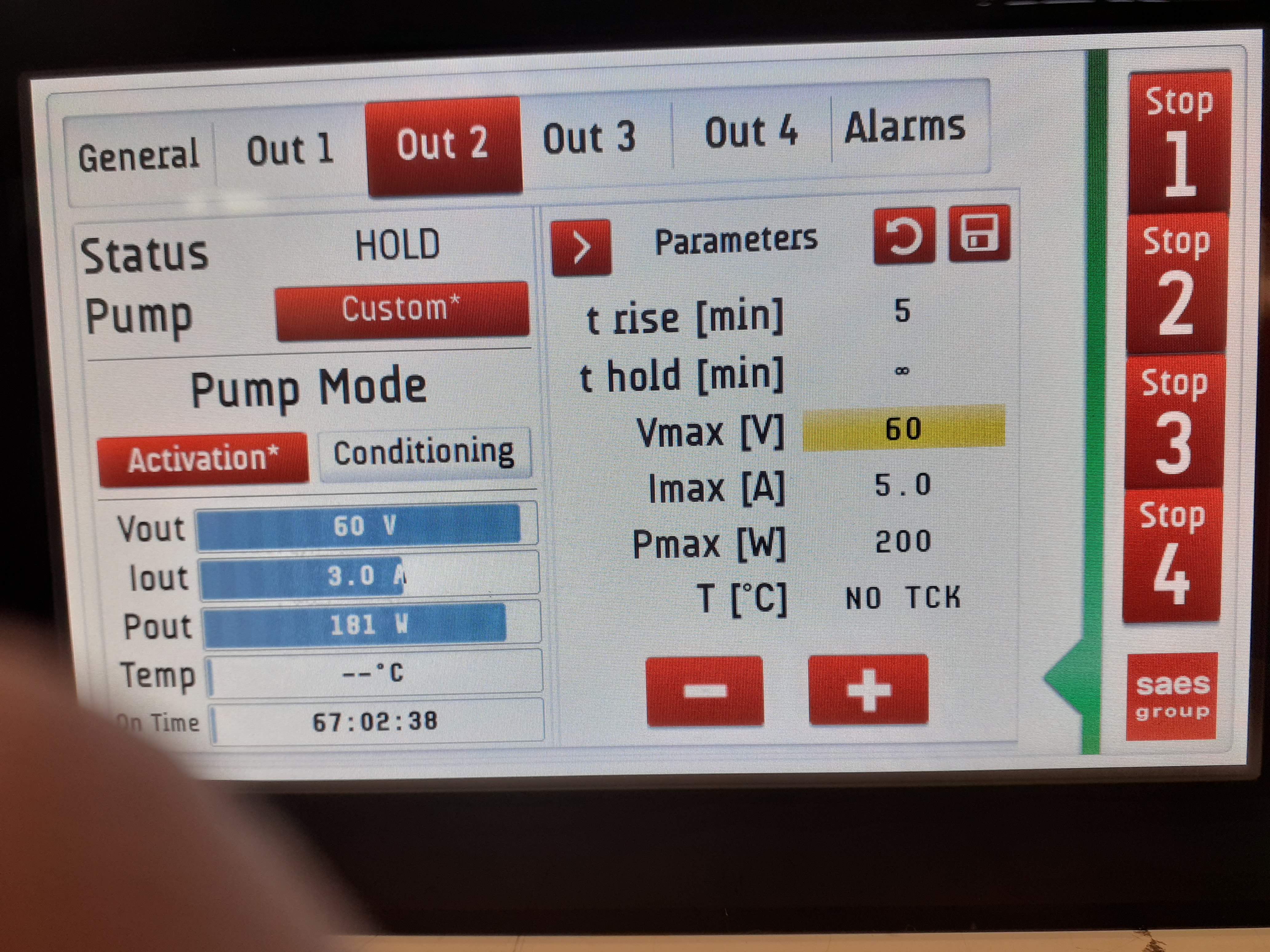
|
| Attachment 10: 20201022_104427.jpg
|

|
| Attachment 11: 20201022_104431.jpg
|

|
| Attachment 12: 20201022_104434.jpg
|
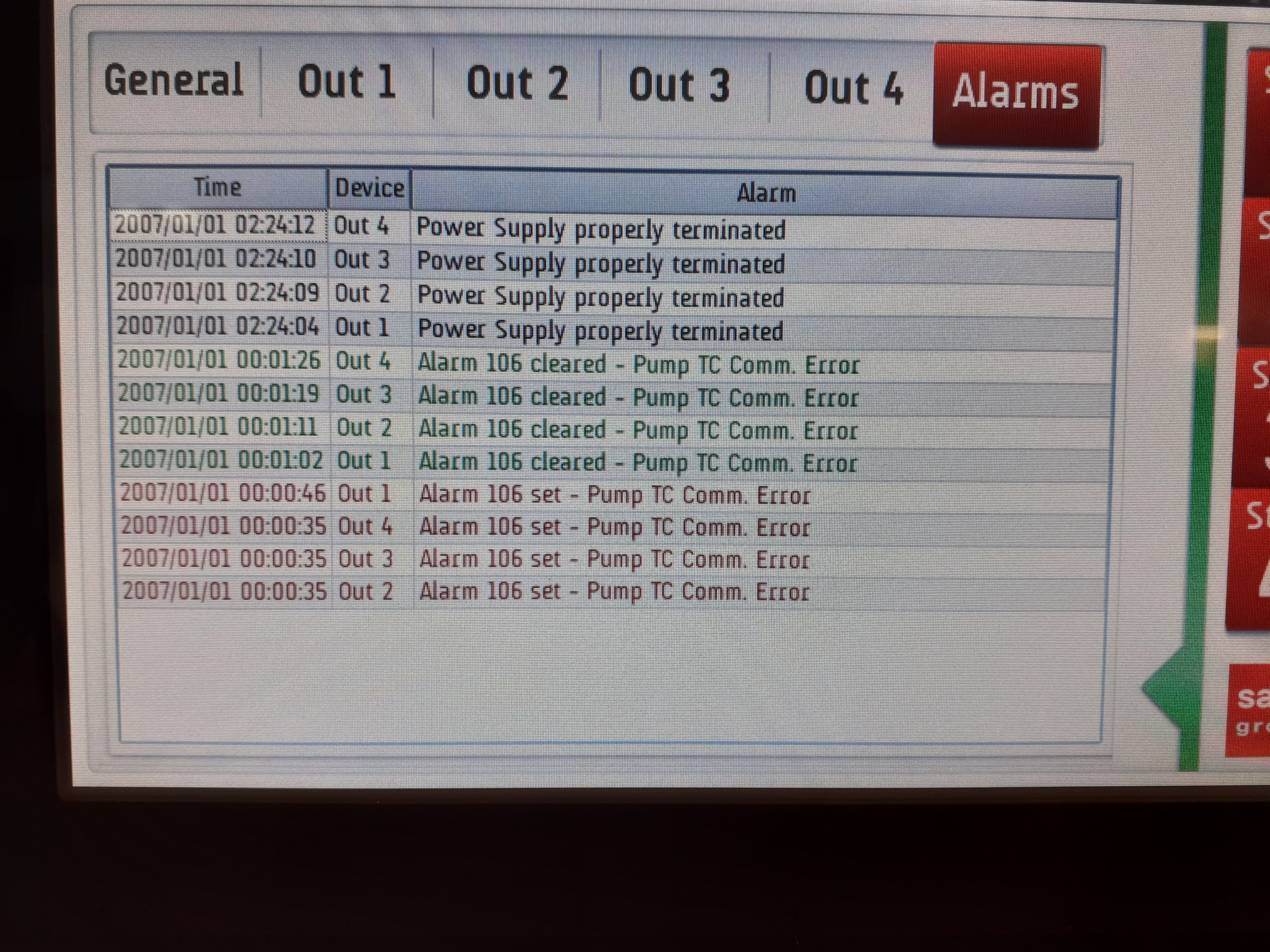
|
| Attachment 13: 20201022_135913.jpg
|
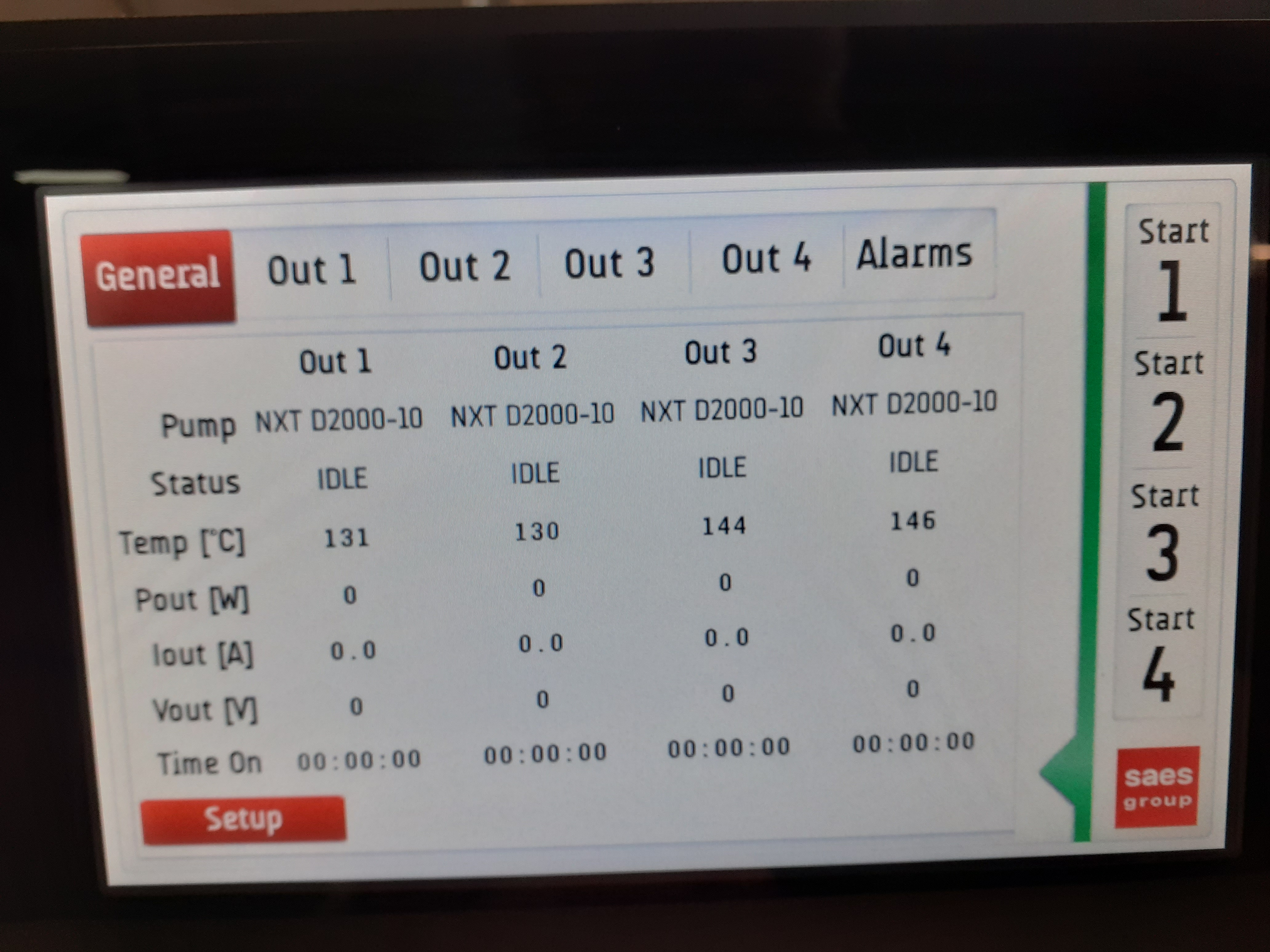
|
| Attachment 14: 20201022_135921.jpg
|

|
| Attachment 15: 20201022_135926.jpg
|

|
| Attachment 16: 20201022_135930.jpg
|
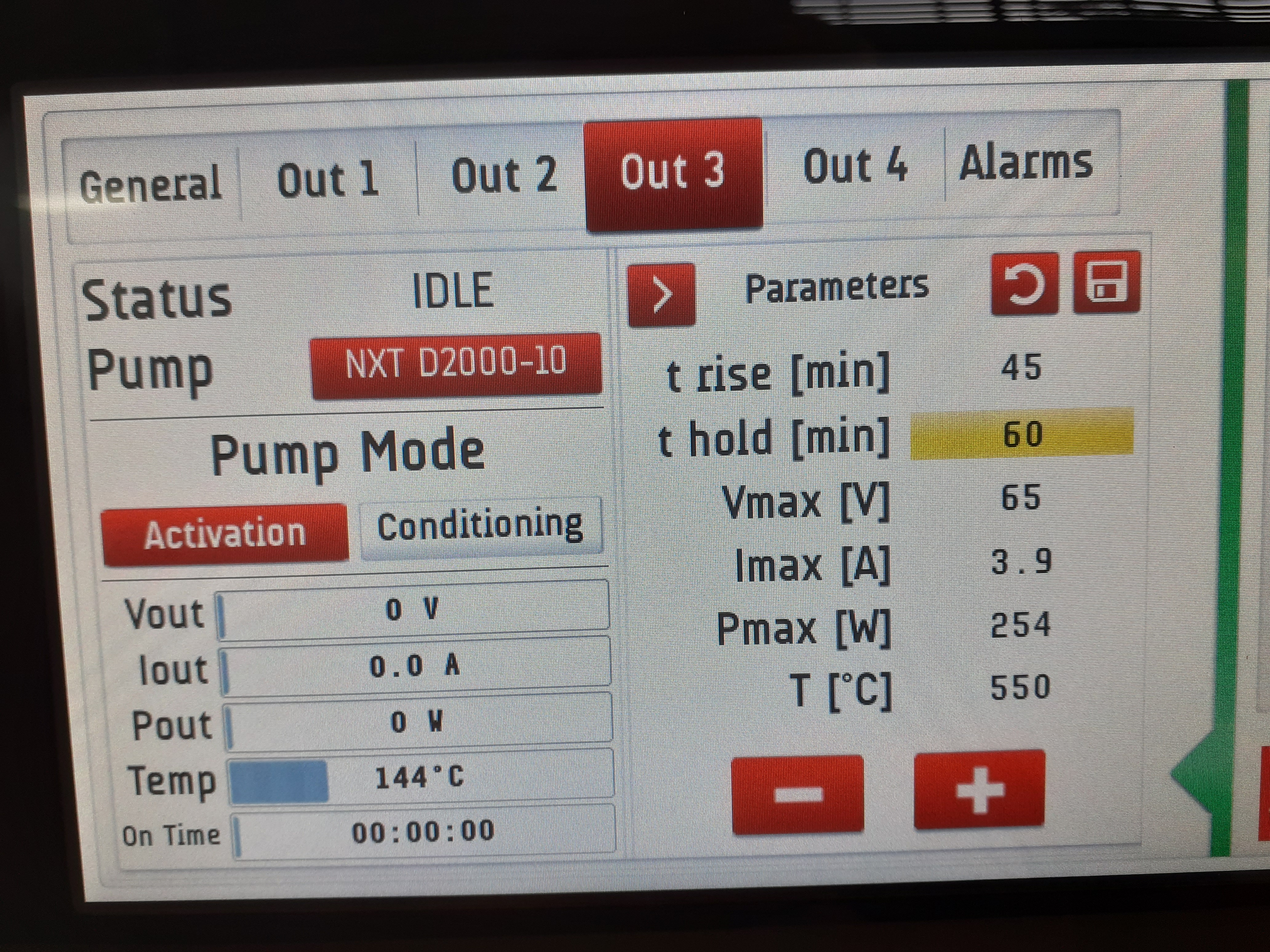
|
| Attachment 17: 20201022_135935.jpg
|

|
| Attachment 18: 20201022_135942.jpg
|

|
| Attachment 19: 20201022_161737.jpg
|
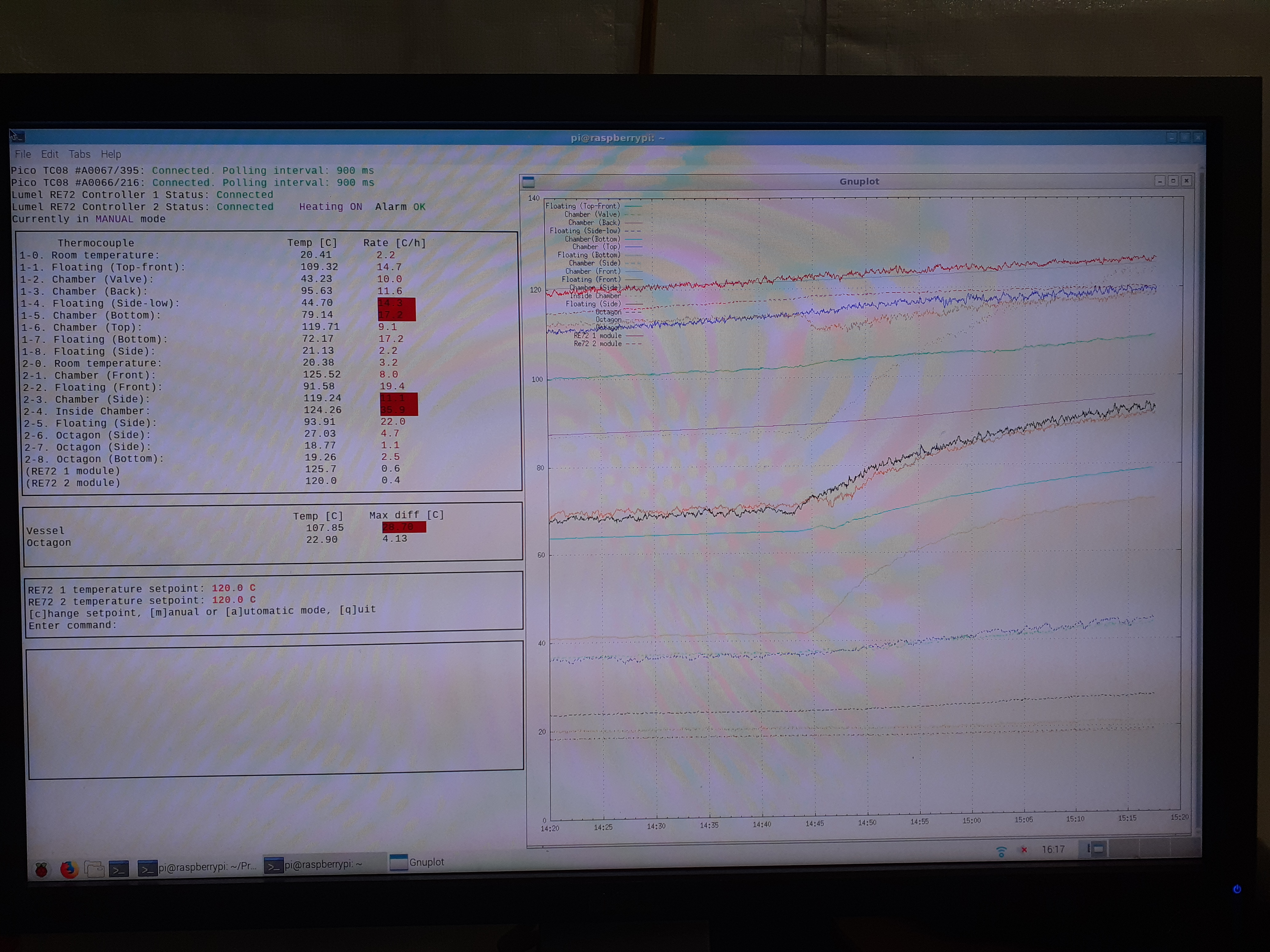
|
|
29
|
Thu Oct 22 22:15:00 2020 |
CB (remotely) | Cooling down after first NEG activation |
Thu 22 October
22:15 Temperatures stables, slowly decreasing.
Bump - rising front corresponds to heaters turned on. Falling front to D2000 turned off?
See attached.
Fri 23 October
09:57 Temperatures stable. See attached.
13:09 Temperatures remain stable. No significant changes.
Sat 24 October
21:27 Temperatures stable. See attached.
Sun 25 October
*Daylight saving is in effect. Time on the Raspberry Pi is no longer incorrect*
07:57 Temperatures stable. See attached.
19:05 Temperatues mostly stable. See attached. Will leave overnight and move setpoint to 80 C early tomorrow morning
Mon 26 October
07:37 Temperatures mostly stable. See attached. Setpoint to 80 C. |
| Attachment 1: 20201022_2214.png
|

|
| Attachment 2: 20201023_0957.png
|

|
| Attachment 3: 20201024_2117.png
|

|
| Attachment 4: 20201025_0757.png
|
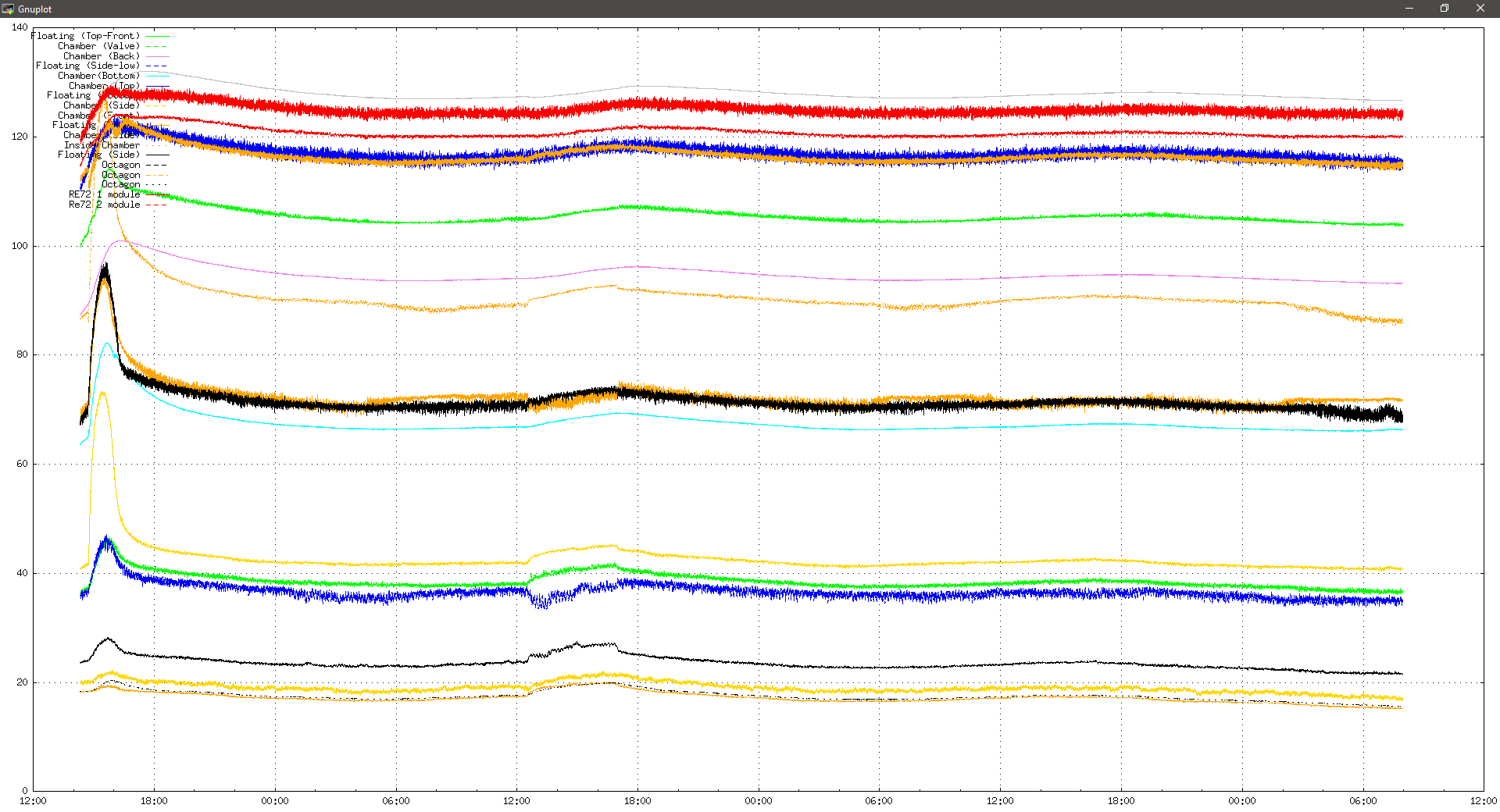
|
| Attachment 5: 20201025_1905.png
|

|
| Attachment 6: 20201026_70736_temps.png
|

|
| Attachment 7: 20201026_0736_ctrl.png
|

|
|
30
|
Mon Oct 26 10:35:05 2020 |
JM, CB(remotely) | Cooling |
10:10 Pressure on the chamber = 3.1e-8mbar. RE-72 temperatures are ~120-125C with set limits at 80C. D2000 temperatures are ~370C. D2000's reduced from 60W to 30W and all UHV 1400s reduced to 50W each to cool both the chamber and the D2000s so that ion pumps can be activated.
10:38 Pressure on the chamber = 1.7e-9mbar. Re-72 temperatures begining to fall and are currently ~117-122C. D2000 temperatures are ~290C.
11:05 Pressure on chamber = 1.1e-9mbar. RE-72 temperatures are ~114-118C. D2000 temperatures ~275C.
11:42 Pressure on chamber = 9e-10mbar. RE-72 temperatures are ~109-113C. D2000 temperatures ~230C. Power in the D2000s reduced to 10W each to speed up cooling.
13:02 Pressure on chamber = 3e-10mbar. RE-72 temperatures are 100-103C. D2000 temperatures ~200C. Power in the UHV 1400s reduced to 25W to speed up cooling. Total heating power is now 325W from the UHV1400s and 40W from the D2000s.
14:11 Temperature plot attached.
15:40 Pressure on chamber = 1.2e-10mbar. RE-72 temperatures are ~80-84C with the heaters starting to control temperature of the bakeout. D2000s temperatures are ~150C. I will leave things as they are to let temperatures reach equillibrium overnight.
27 October
08:00 Temperature stable. See attached.
08:30 Pressure on chamber = 1.2e-10mbar. D2000s temperatures are 150C, have turned them off to cool to below 80C
09:35 Pressure on chamber 1.18e-10mbar. D2000s temperatures are 110C. Bakeout set point reduced to 0C and neg elements switched off. Ion pumps set up and will be activated when D2000 temperatures are below 80C.
Settings on the ion pump have been left to default, except for the ramp rate which has been reduced to 1s from 10s as we are only flashing pumps for a short period of time, and the conversion factor which is set to 150A/torr for D2000 pumps.
10:50 Pressure on the chamber = 7.53e-11mbar. D2000 temperatures at 80C. Gate valve was closed leading to an increase in pressure up to the high -9 / low -8 mbar range. Conclusion at the time was that the UHV1400s were still too hot and thus outgassing at such a rate that caused the large pressure increase. Once the valve was opened again, the pressure dropped to the mid -11 range again. Gate valve has been found to have been installed upside down, this may also contribute to the pressure increase. Due to low pressure on the backing line and neg pumps cooling which will increase pumping power we may not have to close the valve to reach the -12 mbar range however.
After speaking with Keith, valve being installed upside down shouldn't pose any significant difference to obtainable pressure, however would be good to install properly at next chance.
11:45 Pressure on the chamber = 5.55e-11mbar. D2000s temparatures are 75C. Ion pumps activated for first flash of 30s pumping.
11:55 Pressure on the chamber =5.44e-11mbar. Ion pumps flashed for the second time. Pressure given inside 3 ion pumps reached the minimum of 8.9e-12mbar, 4th pump registered 1.3e-10mbar.
13:24 Pressure on the chamber = 4.02e-11mbar. Ion pumps flashed for the third time. Pressure inside ion pumps was the same as last flash.
15:40 Pressure on chamber = 2.88e-11mbar
Find attached plot of pressure (mbar) against time for the pump down from 10:11 on 27/10/20. It looks like negs may have cooled enough to begin pumping nearer the end of the day where the rate of pumping speed appears to increase.
|
| Attachment 1: Screenshot_from_2020-10-26_14-10-08.png
|

|
| Attachment 2: 20201027_0803_temps.png
|
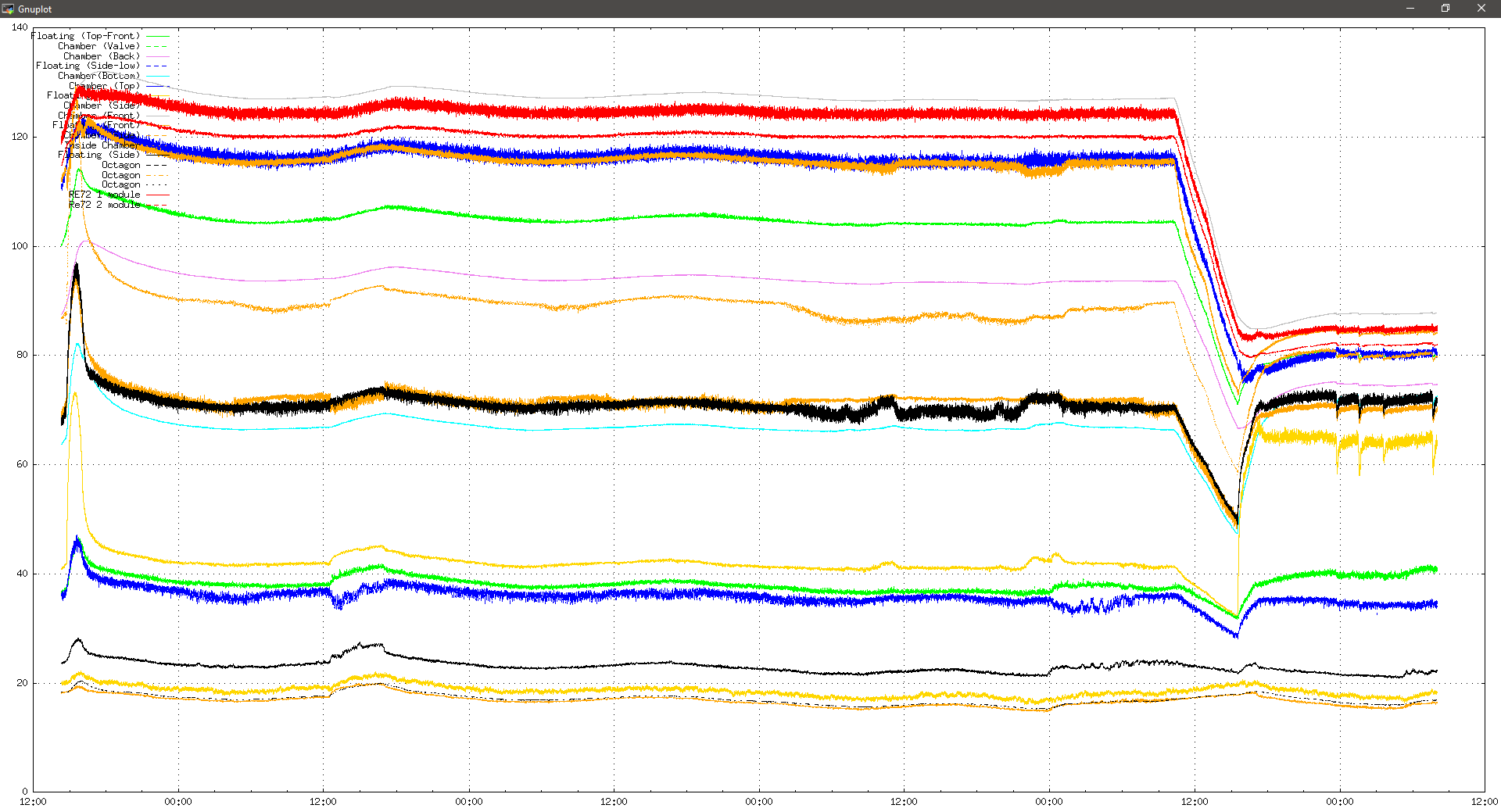
|
| Attachment 3: 27102020_pump_down.png
|
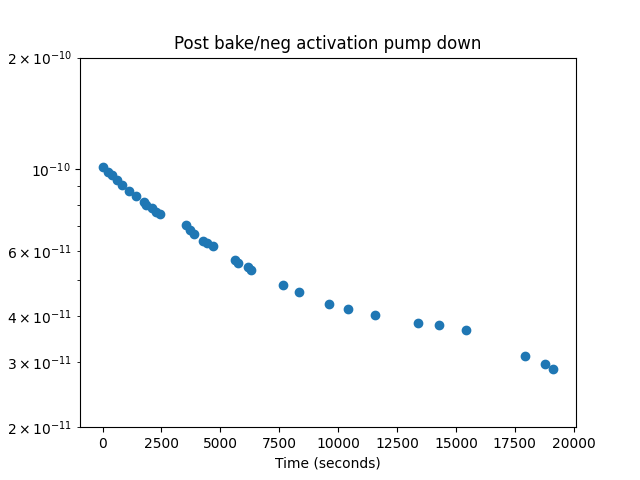
|
| Attachment 4: 27102020_pump_down.png
|

|
|
31
|
Wed Oct 28 10:41:57 2020 |
TD | Wednesday 28 October |
10.32
CARME chamber 5.8e-12mbar (see attachment 1)
Backing 1.6e-08mbar (Edwards vacuum cart w/RGA)
CARME temps - see attachment 2
All SAES D2000-10 & UHV1400 NEG power OFF
All SAES D2000-10 ion pump OFF
Gate valve open
11.01
All SAES D2000-10 ion pump ON
# V/V presssure/mbar
1 5012/5019 4-8e-11
2 5012 < 8.9e-12
3 5012 < 8.9e-12
4 5012 < 8.9e-12
11.04
CARME chamber 5.7e-12mbar
Backing 1.7e-08mbar (Edwards vacuum cart w/RGA)
12.12
CARME chamber 5.3e-12mbar
Backing 1.7e-08mbar (Edwards vacuum cart w/RGA)
All SAES D2000-10 & UHV1400 NEG power OFF
Gate valve open
All SAES D2000-10 ion pump ON
# V/V presssure/mbar
1 5012 < 8.9e-12
2 5012 < 8.9e-12
3 5012 < 8.9e-12
4 5012 < 8.9e-12
All ion pumps now stabilising wrt V/I/pressure
log (pressure) versus time - see attachment 3
16.00
CARME chamber 4.9e-12mbar - see attachment 4
Backing 1.7e-08mbar (Edwards vacuum cart w/RGA)
All SAES D2000-10 & UHV1400 NEG power OFF
Gate valve open
All SAES D2000-10 ion pump ON - see attachment 5
# V/V presssure/mbar
1 5012 < 8.9e-12
2 5012 < 8.9e-12
3 5012 < 8.9e-12
4 5012 < 8.9e-12
All ion pumps now stabilising wrt V/I/pressure
CARME temps - see attachment 6
Observing pressure transients from 5e-12mbar to c. 6-7e-12mbar which recover in c. 5-10 minutes
21.00 CARME chamber 4.7e-12mbar |
| Attachment 1: 20201028_103204.jpg
|

|
| Attachment 2: 20201028_103638.jpg
|
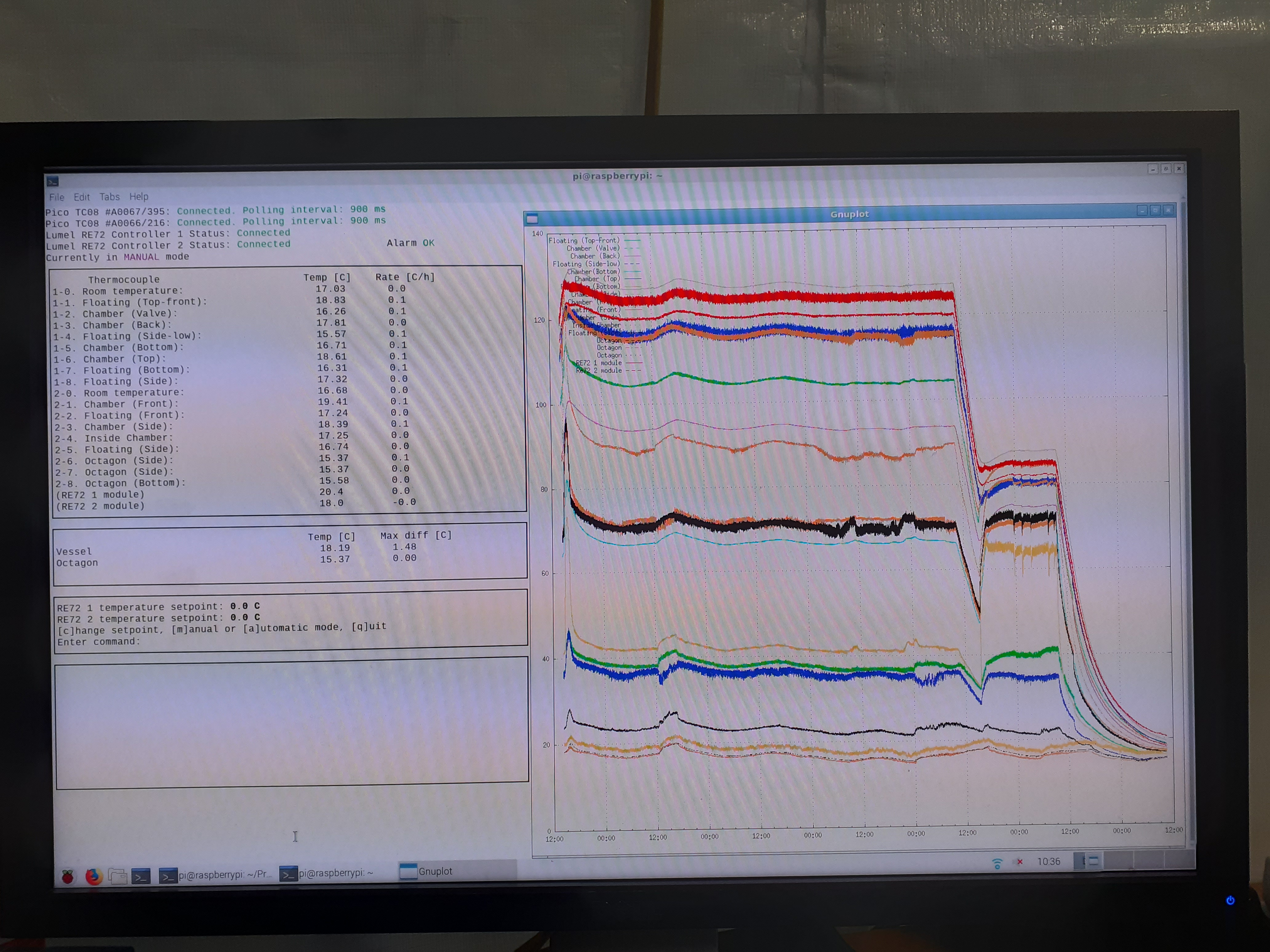
|
| Attachment 3: 28102020_pump_down.png
|

|
| Attachment 4: 20201028_161049.jpg
|
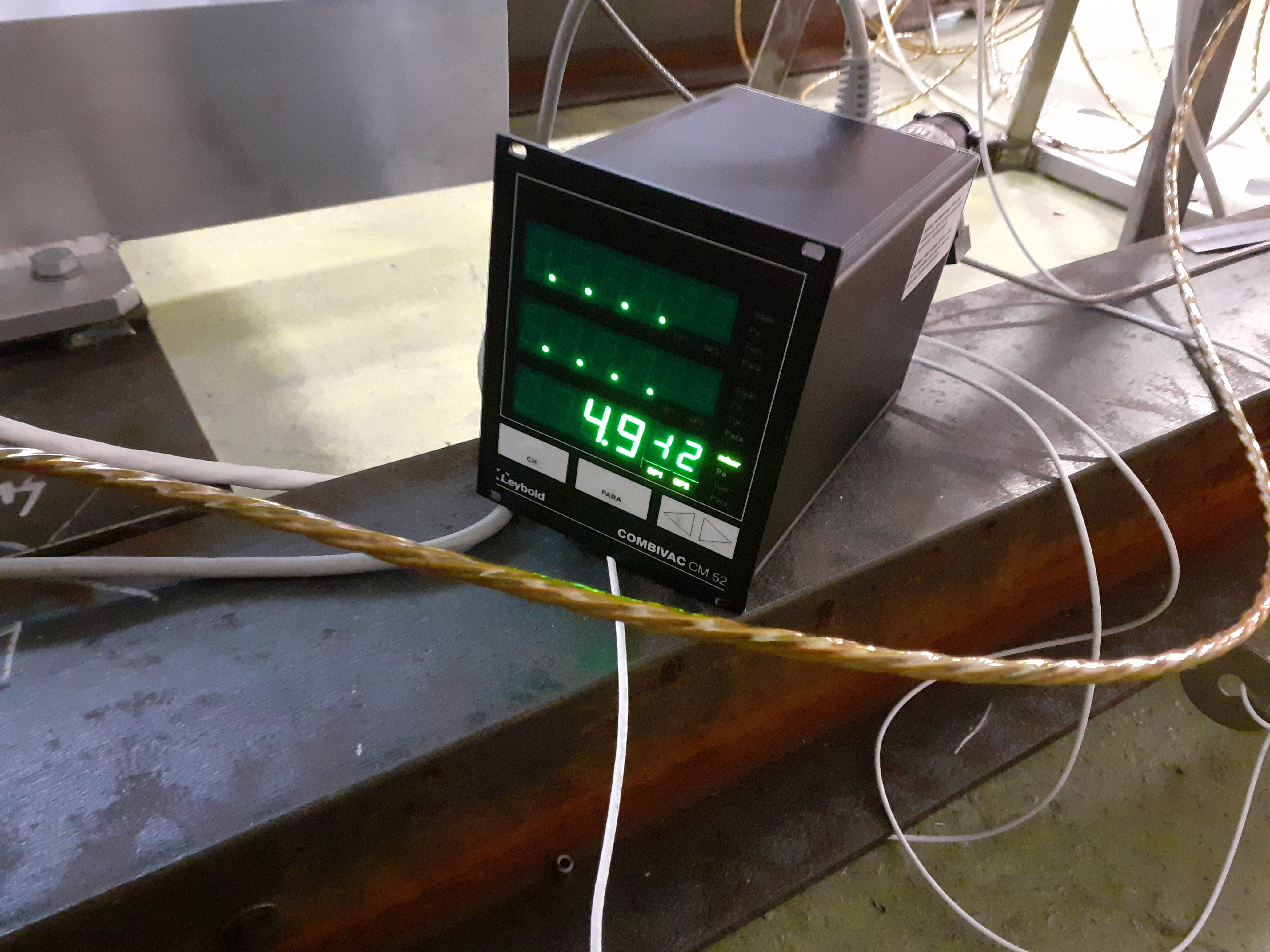
|
| Attachment 5: 20201028_155823.jpg
|
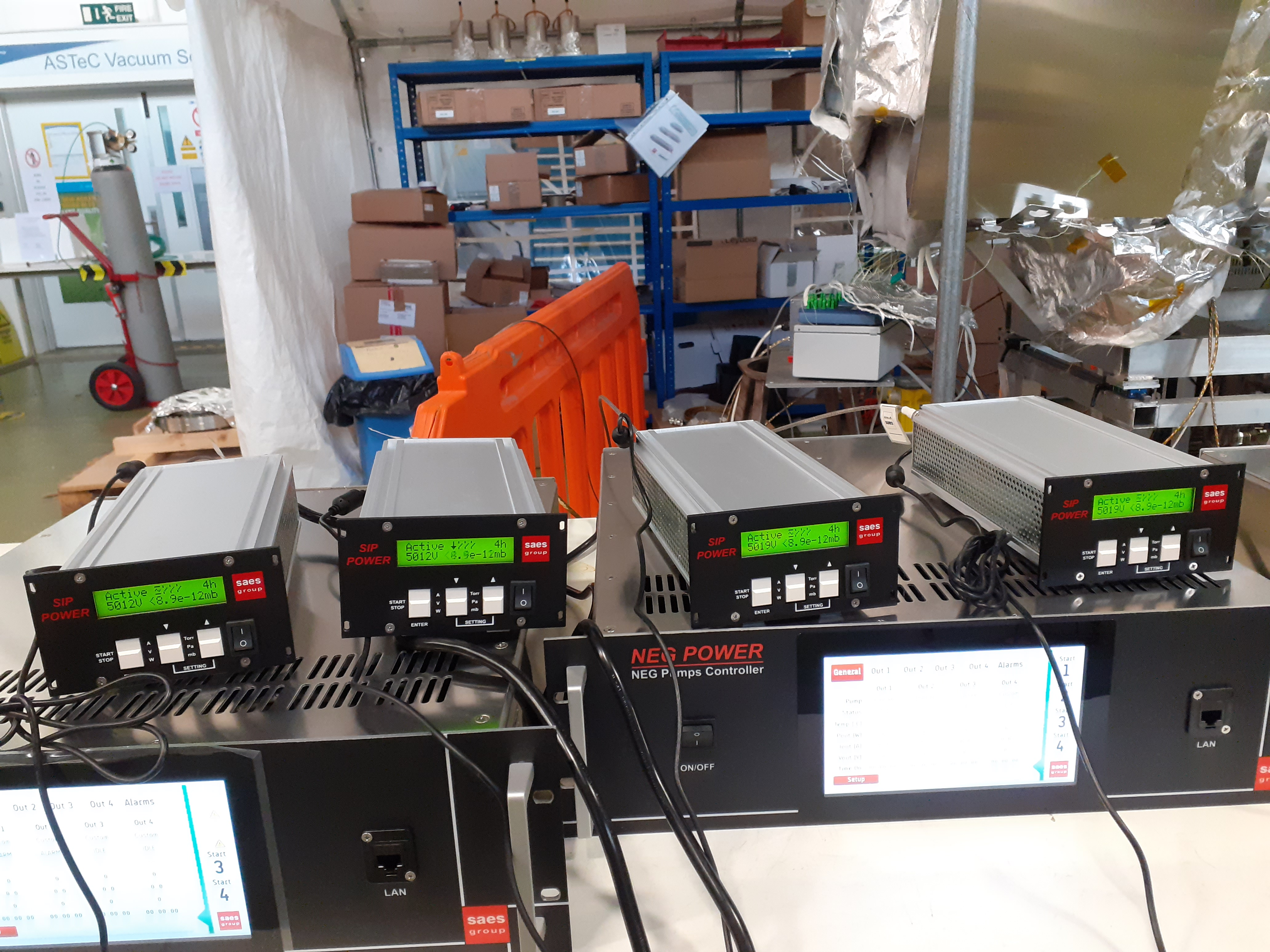
|
| Attachment 6: 20201028_155940.jpg
|

|
|
32
|
Thu Oct 29 08:02:29 2020 |
CB, JM (remotely) | CARME pressure |
Attached is the temperature plot for bakeout period including tags for NEG activation etc.
28 October -> 27 November
--->See shared Excel document for CARME pressure values<---
https://uoe-my.sharepoint.com/:x:/g/personal/cbruno2_ed_ac_uk/EbaoBvhq8zFFtmuakXKjQWQBTqjjzilT6lk9BmchoxlMNQ?e=XU8DzE
30 October
07:30 Baking code has been shut down, we have no log of the temperatures. Restarted (T=0)
19:40 Pressure back in the E-12 mbar range.
31 October
08:47 Back in the low E-11 mbar range. See temperature plot attached.
15:57 Back in the E-12 mbar range.
1 November
12:30 Pressures updated. Temperature plot updated.
2 November
08:52 Pressure reached E-10 mbar overnight, now back in the E-12 range.
Temperature increasing. See attached.
3 November
08:37 Pressure stable in the E-12 mbar range.
15:36 Pressure mostly stable in the E-12 mbar range
17:30 KM reports re-arranging the mains power connection to borrow an extension reel. No obvious effects on pressure.
18:24 Pressure stable in the E-12 mbar range. Updated temperature plot.
4 November
08:39 Pressure stable in the E-12 mbar range.
Temperature plot updated.
19:31 Pressure mostly stable around 5E-12 mbar
5 November
10:26 Pressure stable in the E-12 mbar range.
6 November
12:26 Pressure stable in the E-12 mbar range.
7 November
11:50 Pressure stable in the E-12 mbar range.
Temperature plot updated.
8 November
20:39 Pressure increasing again. Now in 1E-11 mbar range
9 November
08:50 Pressure returned to E-12 mbar range.
Temperature plot updated
16:51 Pressure fluctuating around 7E-12 mbar range.
10 November
09:04 Pressure oscillating in the 7E-12 mbar range
11 November
08:27 Pressure mostly stable in the 5E-12 mbar range
12 November
08:21 Pressure mostly stable in the 5E-12 mbar range
13 November
08:29 Pressure increased suddenly to 7E-9 mbar yesterday at 14:00, from 6.5E-12 mbar. Was the valve closed? (Confirmed
by KM)
Pressure appears to be slowly recovering. Currently in the low E-10 mbar range.
Temperature plot updated.
15:40 Pressure does not appear to drop. Currently stable around 2E-10 mbar
18:10 KM reports Ion pumps have gone off (tripped by high pressure?)
IE514 gauge still reading 1E-10, but SAES D2000-10 ion pressure gauge reading 1E-12.
Someone will check tomorrow in person.
14 November
08:13 Pressure stable in the 2E-10 mbar range. Does not appear to decrease.
15 November
08:24 Pressure stable in the 2E-10 mbar range
16 November
08:23 Pressure increased to 1E-9 mbar (potentially due to heating being turned on at week start).
17 November
08:18 Pressure back in the E-12 mbar range since yesterday afternoon.
Change was sudden and CM52 control module appears to have been moved in-between.
Unclear what was done locally.
18 November
08:40 Pressure mostly stable in the 5E-12 mbar range.
19 November
07:55 Pressure remains stable in the E-12 mbar range.
Temperature plot updated
20 November
08:00 Pressure remains stable in the E-12 mbar range.
21 November
14:16 Pressure remains stable in the 5E-12 mbar range.
22 November
08:08 Pressure remains stable
23 November
08:24 Pressure remains stable
24 November
08:05 Pressure remains stable
See ELOG entry by JM
25 November
See ELOG entry by TD.
Valve partly closed.
26 November
08:58 Pressure in the E-10 mbar range, very slowly decreasing
27 November
21:07 Pressure stable in the 2E-10 mbar range. Does not appear to be decreasing
28 November
17:49 Pressure stable in the 2E-10 mbar range. |
| Attachment 1: 20201029_080001.jpg
|
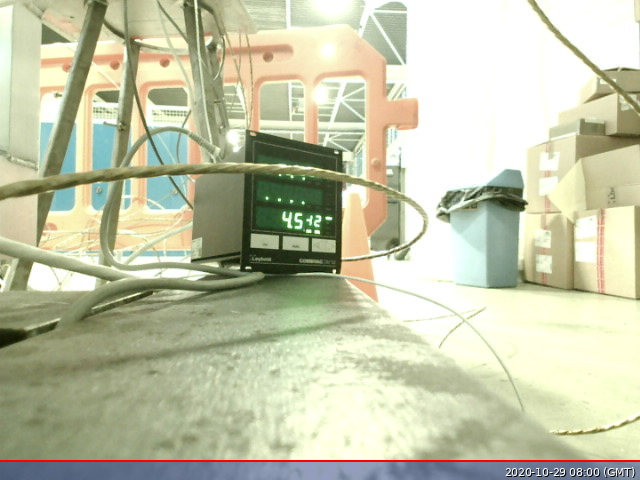
|
| Attachment 2: Bakeout_pump_down.png
|
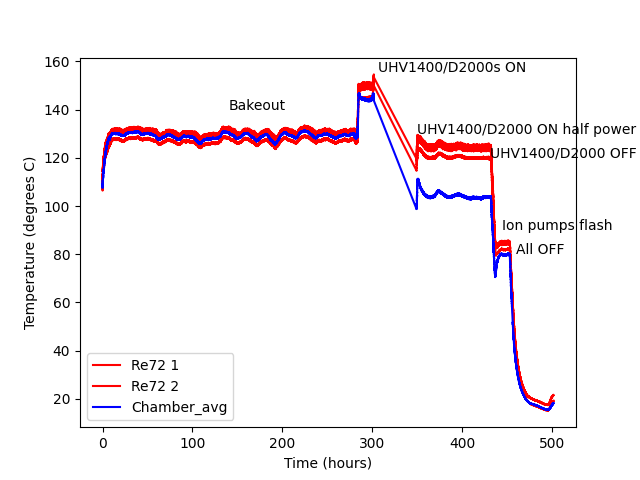
|
| Attachment 3: 20201119_temps.png
|

|
|
33
|
Tue Nov 10 12:25:29 2020 |
JM | Cable harnesses |
The length of the wire needed was estimated with the aid of a scale image of the detectors in the CARME chamber and foam model pieces. Wire length estimated by simply cutting wire so that it 'fits' the scale model and by taking coordinates of the end points of the longest sections of wire needed on the model and calculating a bezier curve to estimate wire length. Bezier curve calculated by inputting the endpoints of the wire and control points such that the wire comes out of the connector at the specified angle in the scale diagram. Figure 1 shows the bezier curve (orange), distance between the endpoints (green) and the control point plot. The length of wire required by the bezier curve is approximately that of cutting wire to fit the scale model.
Two groups of harnesses are needed to be built, a short section which correspond to the top and bottom of the detectors, and longer sections needed for the sides of the detectors. Lengths of these wires is;
Short: 225 mm
Long: 285 mm
Wire is cut to length using a circular object with the required circumference. Wire is wrapped round the object and cut to give required length. Wire is then stripped, crimped and inserted into the connectors with the correct pin assignment. Inserting wire into connectors acts as a good quality check, as incorrectly crimped wires will not fit into connectors. Crimp is set to setting 12 for the male crimps and 10 for the female crimps. Wire stripper has to be cleaned of stripped ends often as it is liable to jam and wire must be inserted into stripper straight, else strip will clip some of the conductors in the wire.
As of 9/11/20 two harnesses (1 long, 1 short) have been constructed.
8 harnesses constructed and sent to DAresbury for cleaning 20/11/20 |
| Attachment 1: 20201102_155336.jpg
|
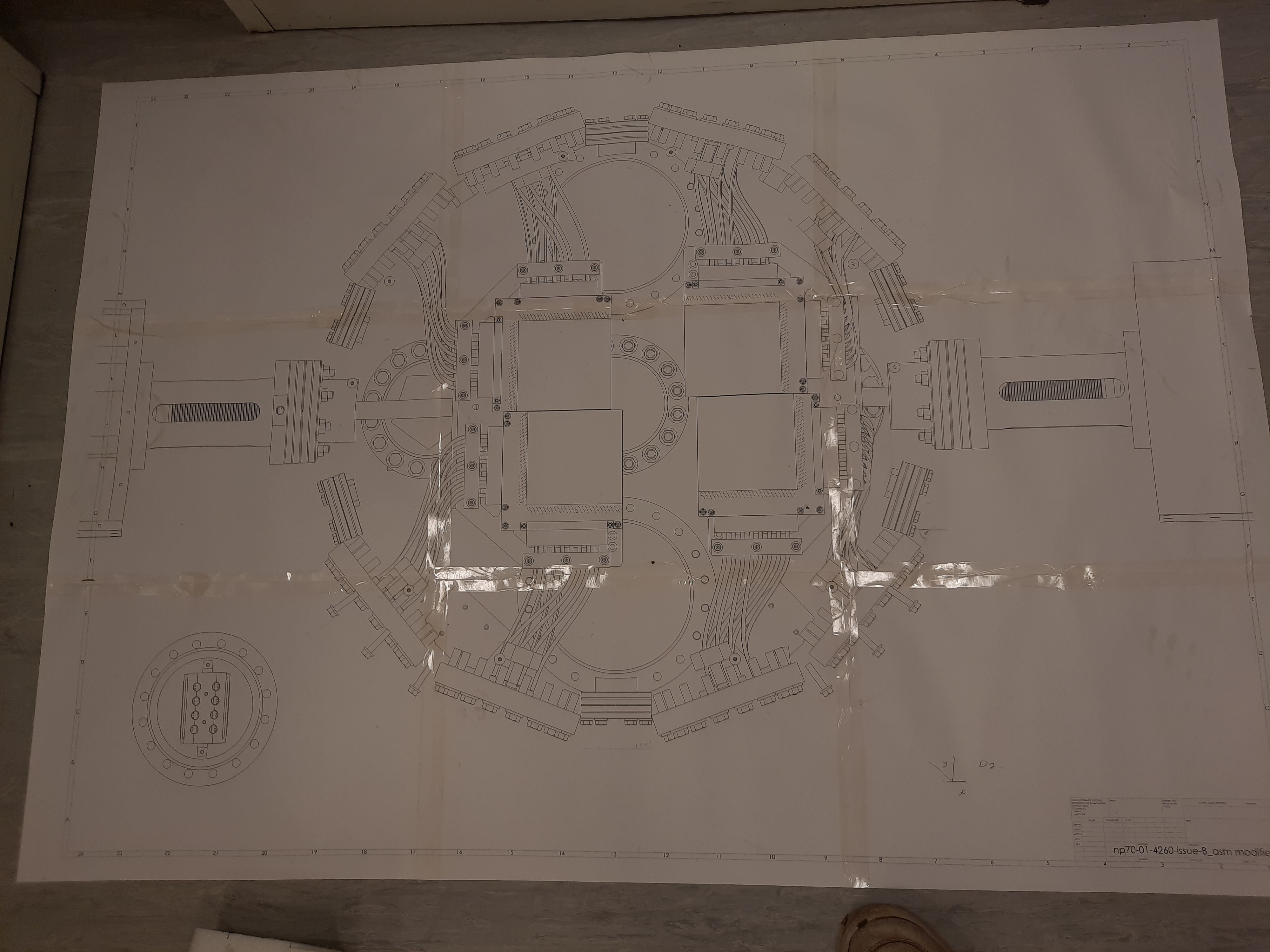
|
| Attachment 2: Figure_1.png
|

|
| Attachment 3: 20201102_154648.jpg
|
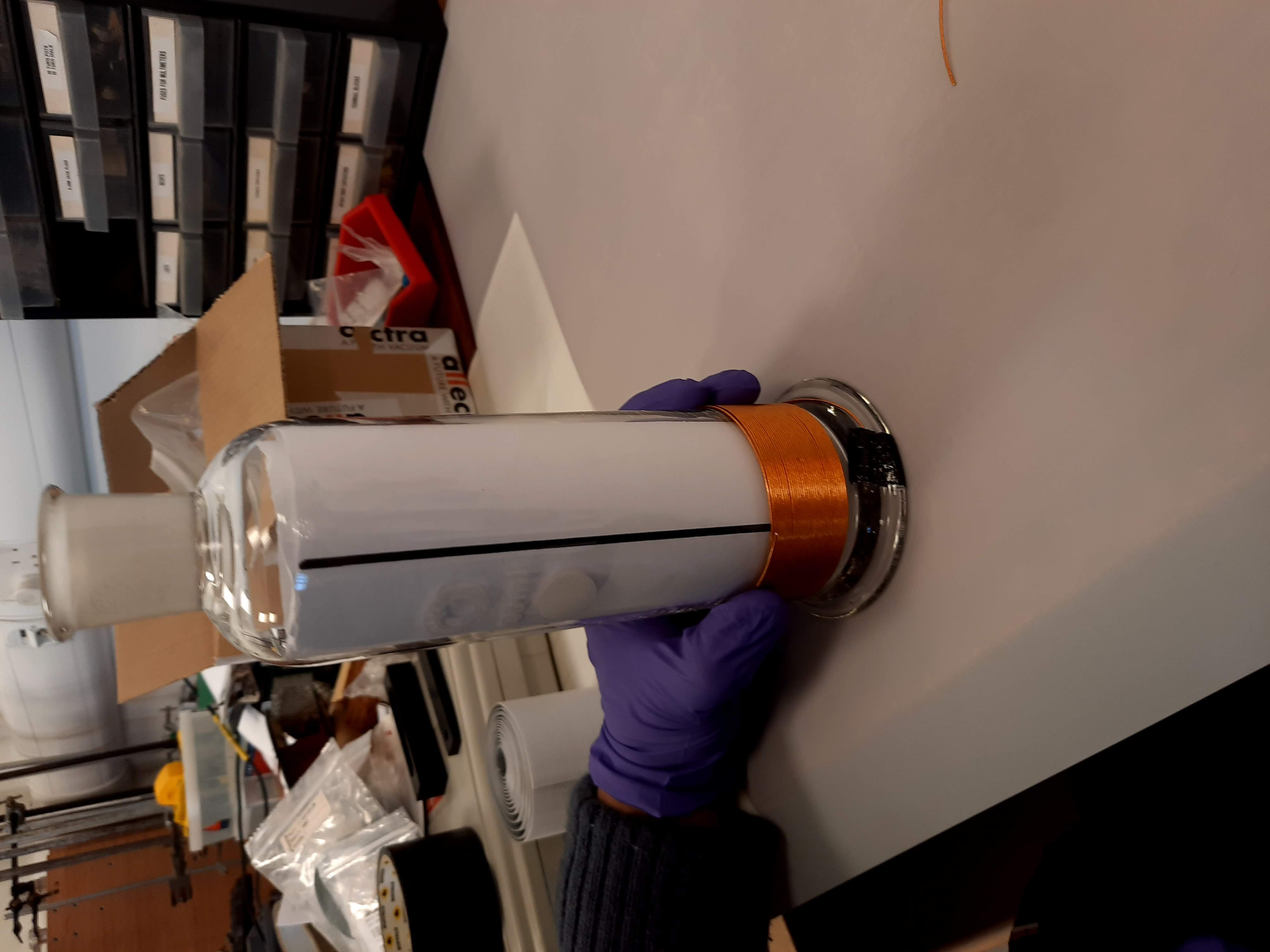
|
| Attachment 4: Photos.zip
|
|
34
|
Tue Nov 24 12:24:01 2020 |
JM | RGA scans |
RGA laptop passcode: tw%11&STA-
RGA scans set up and plotting data as of 11:44
RGA is set to the multiplier mode (4.44e-8mbar) with an accuracy setting of 8, these are for the most sensitive scans. RGA is set to scan masses 2, 12, 16, 18, 28, 32, 40 and 44 in the range 1e-9 to 1e-14mbar. Mass2=7.85e-11mbar, Mass12=1.45e-12mbar, Mass16=1.41e-11mbar, Mass18=4.78e-10mbar, Mass28=1.53e-11mbar, Mass32=3.46e-12mbar, Mass40 = 1e-14mbar, Mass44= 3e-13mbar. Slight variability in each measurement is ver small for higher pressures and larger for lower pressures (see image attached).
Plan is to switch each ion pump off individually and observe the effect on the RGA scans. Once off I will leave for 30 mins to see if any difference can be seen. Afterwards I will switch of 2 pumps then 4 pumps at a time.
12:06 Ion pump 1 (furthest left pump=1, furthest right=4) turned off, no immediate change in RGA.
12:38 No change in RGA, turning pump 1 on again and switching off pump 2. Pump 1 took ~15s to stabilise back to a pressure of <8.9e-12mbar once turned on again.
13:08 No change in RGA, turning pump 2 on again and switching off pump 3. Pump 2 took ~15s to stabilise back to a pressure of <8.9e-12mbar.
13:38 No change in RGA, turning pump 3 on again and switching off pump 4. Pump 2 took ~15s to stabilise back to a pressure of <8.9e-12mbar.
14:08 No change in RGA, all pumps back ON. RGA has not changed since pumps wer switched off and on, pressure on the hot cathode gauge has risen slightly however I think this is due to the day/night cycle of the pressure.
14:12 All 4 ion pumps turned off
15:12 No observable change in the RGA
15:33 Ion pumps all back ON. No change in RGA |
| Attachment 1: 20201124_124107.jpg
|

|
|
35
|
Wed Nov 25 10:39:37 2020 |
TD | Wednesday 25 November |
10.39
CARME XHV chamber pressure 6.0e-12mbar
Backing 2.1e-08mbar (Edwards vacuum cart w/RGA)
CARME temps - heaters OFF - chamber at ambient
temperature
All SAES D2000-10 & UHV1400 NEG power OFF
All SAES D2000-10 ion pump ON
# V/V presssure/mbar
1 5012 < 8.9e-12
2 5012 < 8.9e-12
3 5012 < 8.9e-12
4 5012 < 8.9e-12
Gate valve open
attachment 1 - analog RGA scan (as found this am)
attachment 2 - scan mode
c. 11.15
AH partially closes gate valve using c. 2 bar air pressure
VCARME XHV chamber pressure increases c. 7e-9mbar immediately
attachment 3 - RGA scan - no obvious change in RGA trends!
attachments 4 & 5 - VAT valve indicators - upper (partially open/closed) and lower (closed)
11.33 CARME XHV chamber pressure 6.6e-9mbar
Backing 2.2e-08mbar (Edwards vacuum cart w/RGA)
All SAES D2000-10 ion pump ON
# V/V presssure/mbar
1 5012 < 8.9e-12
2 5012 < 8.9e-12
3 5012 < 8.9e-12
4 5012 < 8.9e-12
All SAES D2000-10 ion pump OFF
11.40 CARME XHV chamber pressure 5.64e-9mbar
11.46 CARME XHV chamber pressure 5.01e-9mbar
No change in RGA trends!
12.01 CARME XHV chamber pressure 3.78e-9mbar
No change in RGA trends!
12.11 CARME XHV chamber pressure 3.10e-9mbar
12.42 CARME XHV chamber pressure 1.81e-9mbar
Backing 2.4e-08mbar (Edwards vacuum cart w/RGA)
No change in RGA trends!
13.20 CARME XHV chamber pressure 1.06e-9mbar
Backing 2.4e-08mbar (Edwards vacuum cart w/RGA)
No change in RGA trends!
13.36 CARME XHV chamber pressure 8.93e-10mbar
Backing 2.4e-08mbar (Edwards vacuum cart w/RGA)
No change in RGA trends!
13.59 CARME XHV chamber pressure 7.07e-10mbar
Backing 2.5e-08mbar (Edwards vacuum cart w/RGA)
No change in RGA trends!
14.00 Leybold turbo OFF - decelerating
14.30 Leybold turbo OFF - decelerating - 466Hz
CARME XHV chamber pressure 5.62e-10mbar
Backing 2.1e-08mbar (Edwards vacuum cart w/RGA)
No change in RGA trends!
14.40 1x SAES D2000-10 ion pump switched on briefly - settles in c. 10s - pressure < 8.9e-
12mbar
All 4x D2000-10 ion pumps OFF
15.01 Leybold turbo OFF - decelerating - 125Hz
CARME XHV chamber pressure 4.78e-10mbar
Backing 1.4e-08mbar (Edwards vacuum cart w/RGA)
No change in RGA trends!
15.10 Abrupt increase in RGA trends - see attachment 6
Leybold turbo OFF - decelerating - 60Hz
CARME XHV chamber pressure 4.53e-10mbar
Backing 2.6e-08mbar (Edwards vacuum cart w/RGA)
15.19 4x SAES D2000-10 ion pumps ON
RGA record 04.24.00
15.24 see attachment 7 - RGA transient recovering - turbo stopped?
15.10 Leybold turbo OFF - stopped - 0Hz
CARME XHV chamber pressure 4.40e-10mbar
Backing 1.1e-08mbar (Edwards vacuum cart w/RGA)
All SAES D2000-10 ion pump ON
# V/V presssure/mbar
1 5012 < 8.9e-12
2 5012 < 8.9e-12
3 5012 < 8.9e-12
4 5012 < 8.9e-12
16.10 VAT gate valve partially closed
Leybold turbo OFF - stopped - 0Hz
CARME XHV chamber pressure 3.88e-10mbar
Backing 9.8e-09mbar (Edwards vacuum cart w/RGA)
RGA traces recovered to pre-transient levels and stable
All SAES D2000-10 ion pump ON
# V/V presssure/mbar
1 5012 < 8.9e-12
2 5012 < 8.9e-12
3 5012 < 8.9e-12
4 5012 < 8.9e-12 |
| Attachment 1: 20201125_104631.jpg
|
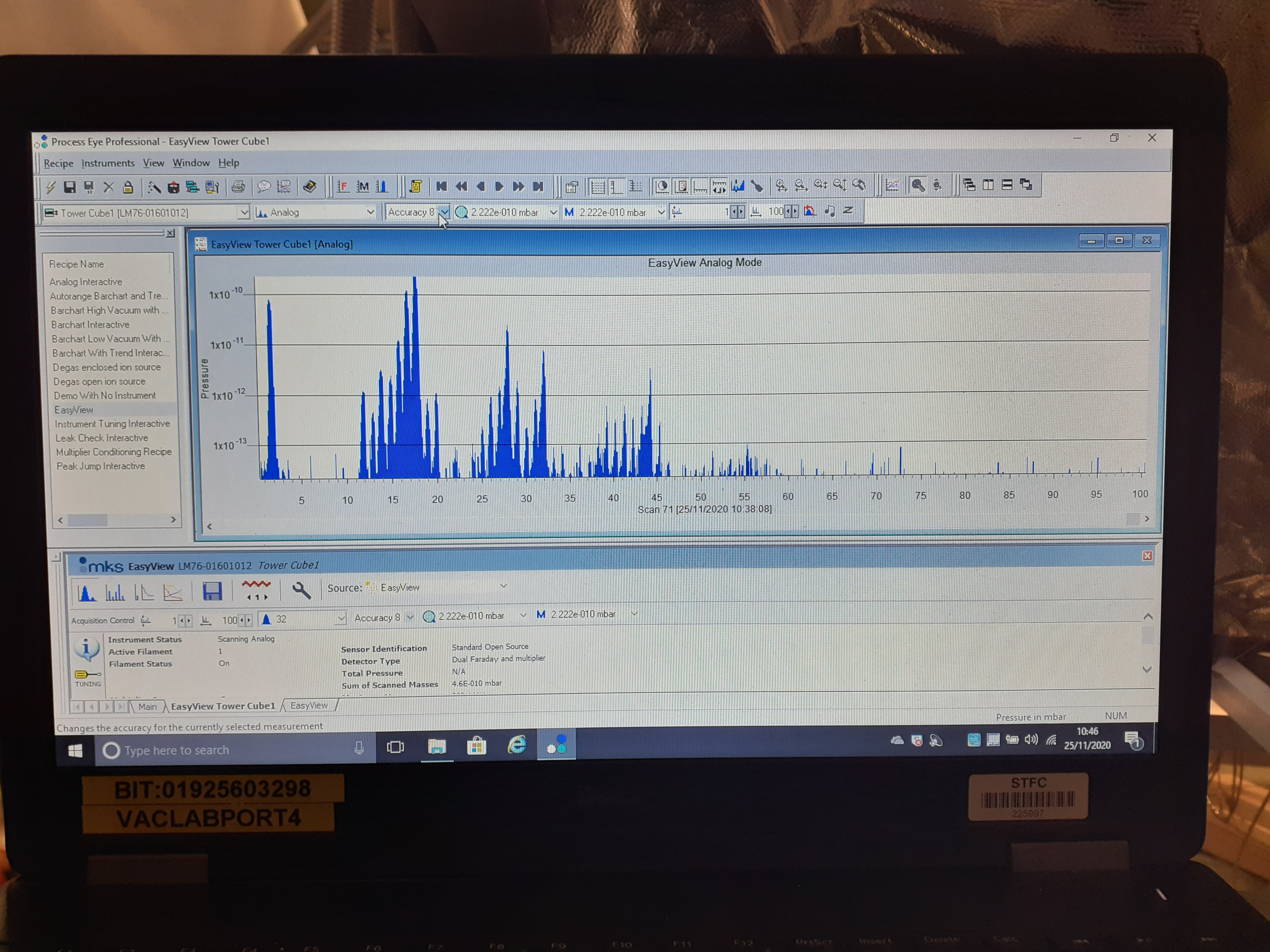
|
| Attachment 2: 20201125_110500.jpg
|
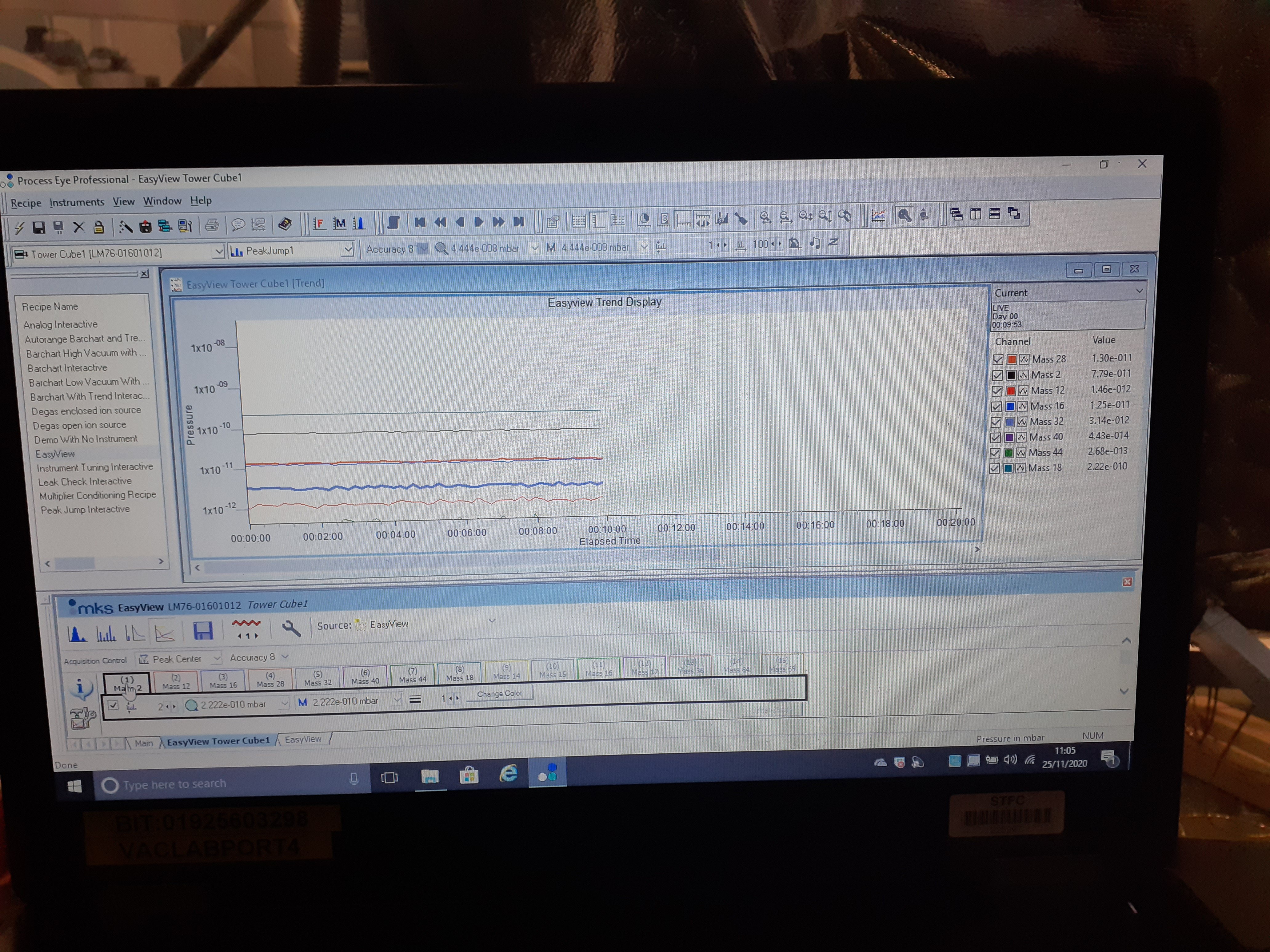
|
| Attachment 3: 20201125_111937.jpg
|
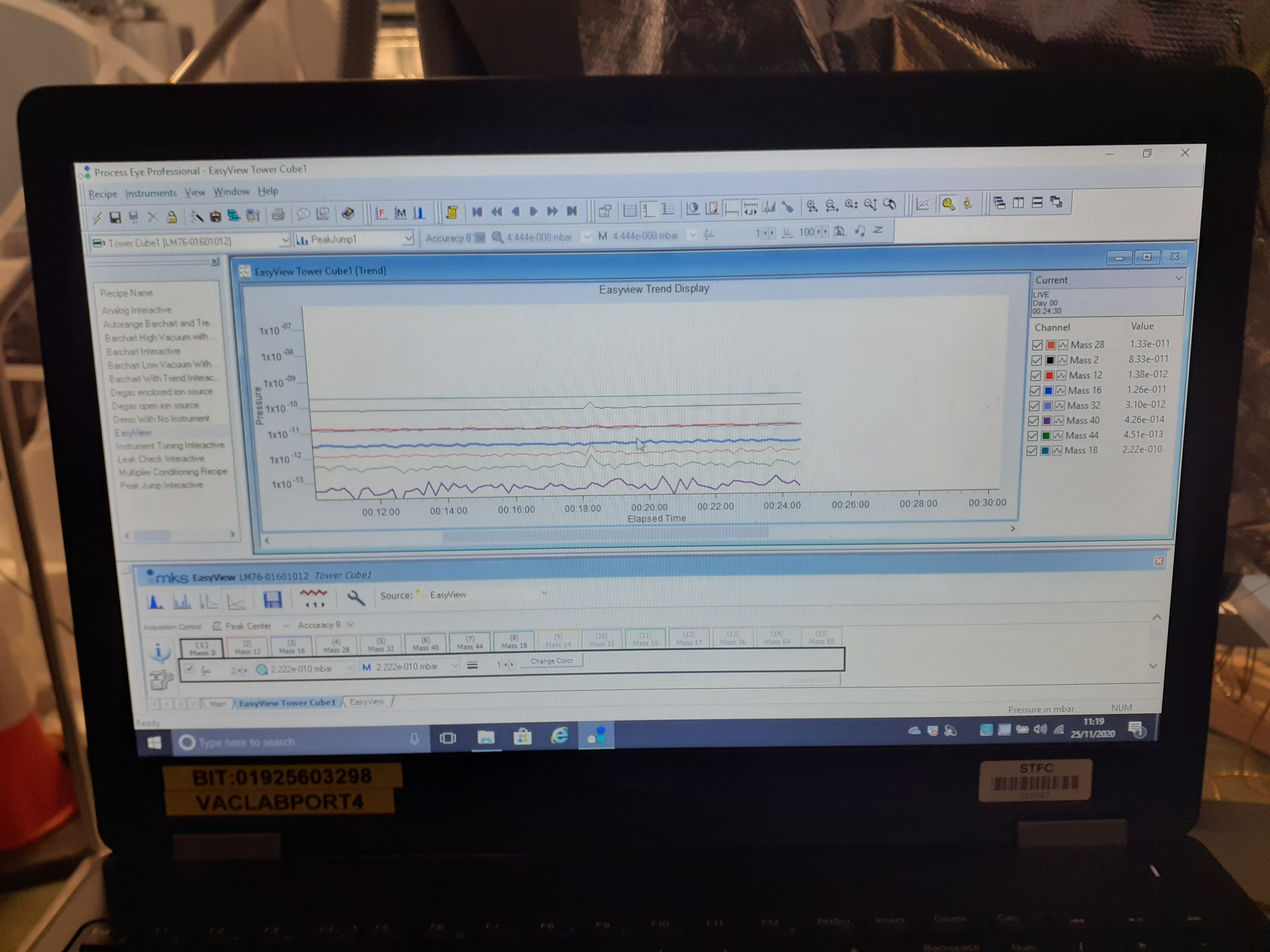
|
| Attachment 4: 20201125_111954.jpg
|
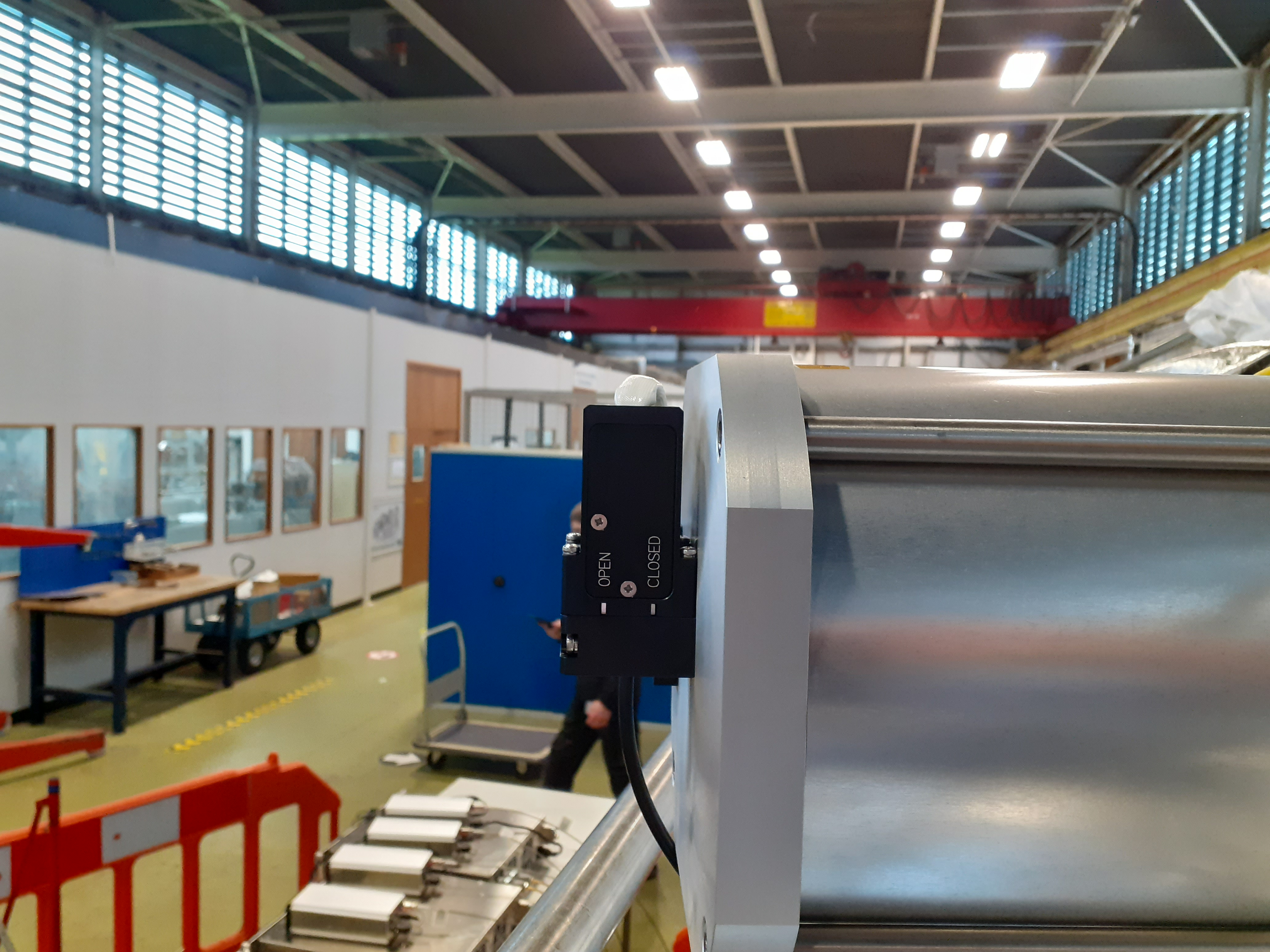
|
| Attachment 5: 20201125_112003.jpg
|

|
| Attachment 6: 20201125_151232.jpg
|
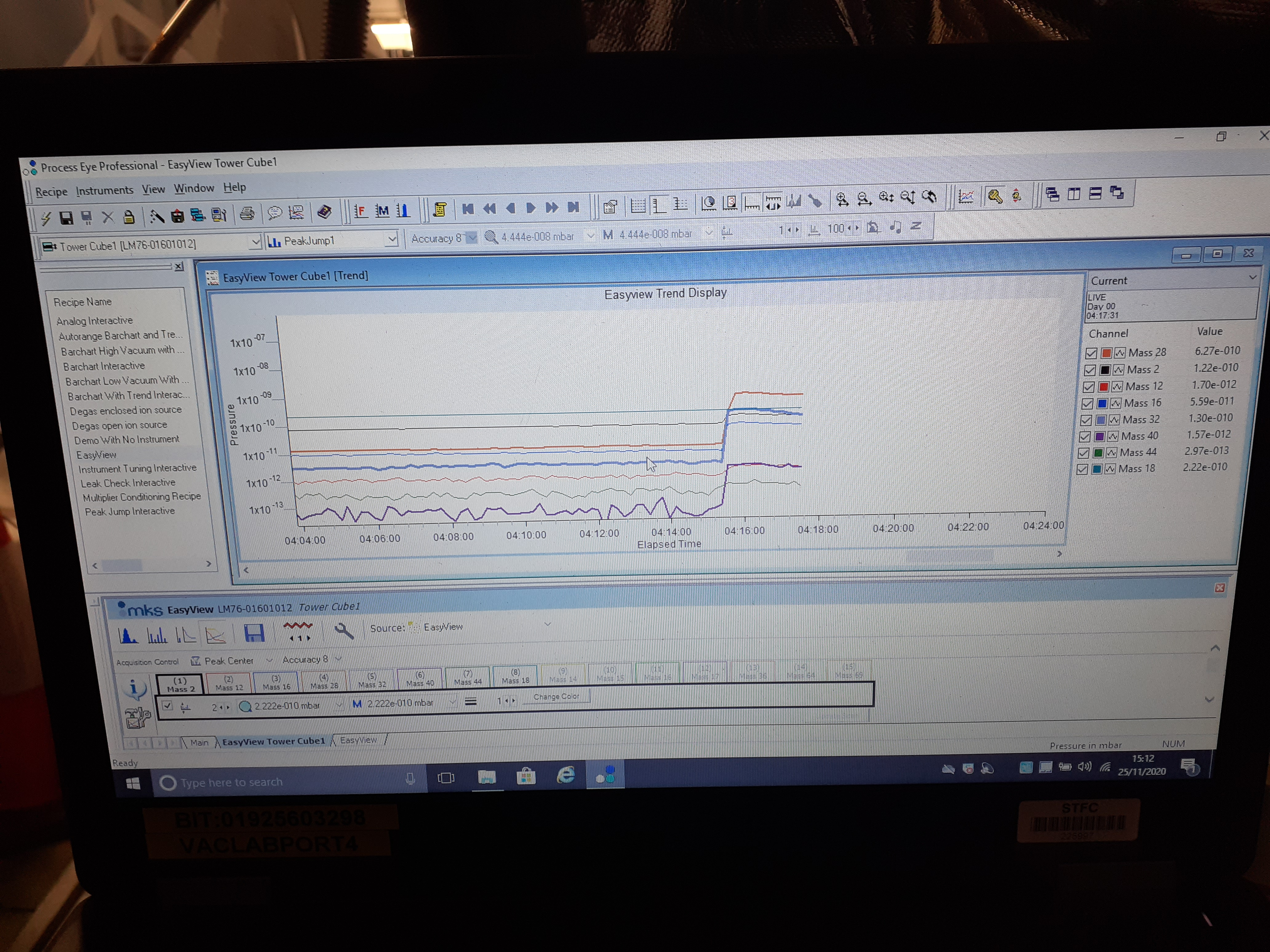
|
| Attachment 7: 20201125_152354.jpg
|

|
|
36
|
Fri Dec 4 16:49:36 2020 |
TD | Friday 4 December |
|
| Attachment 1: 20201204_161412.jpg
|
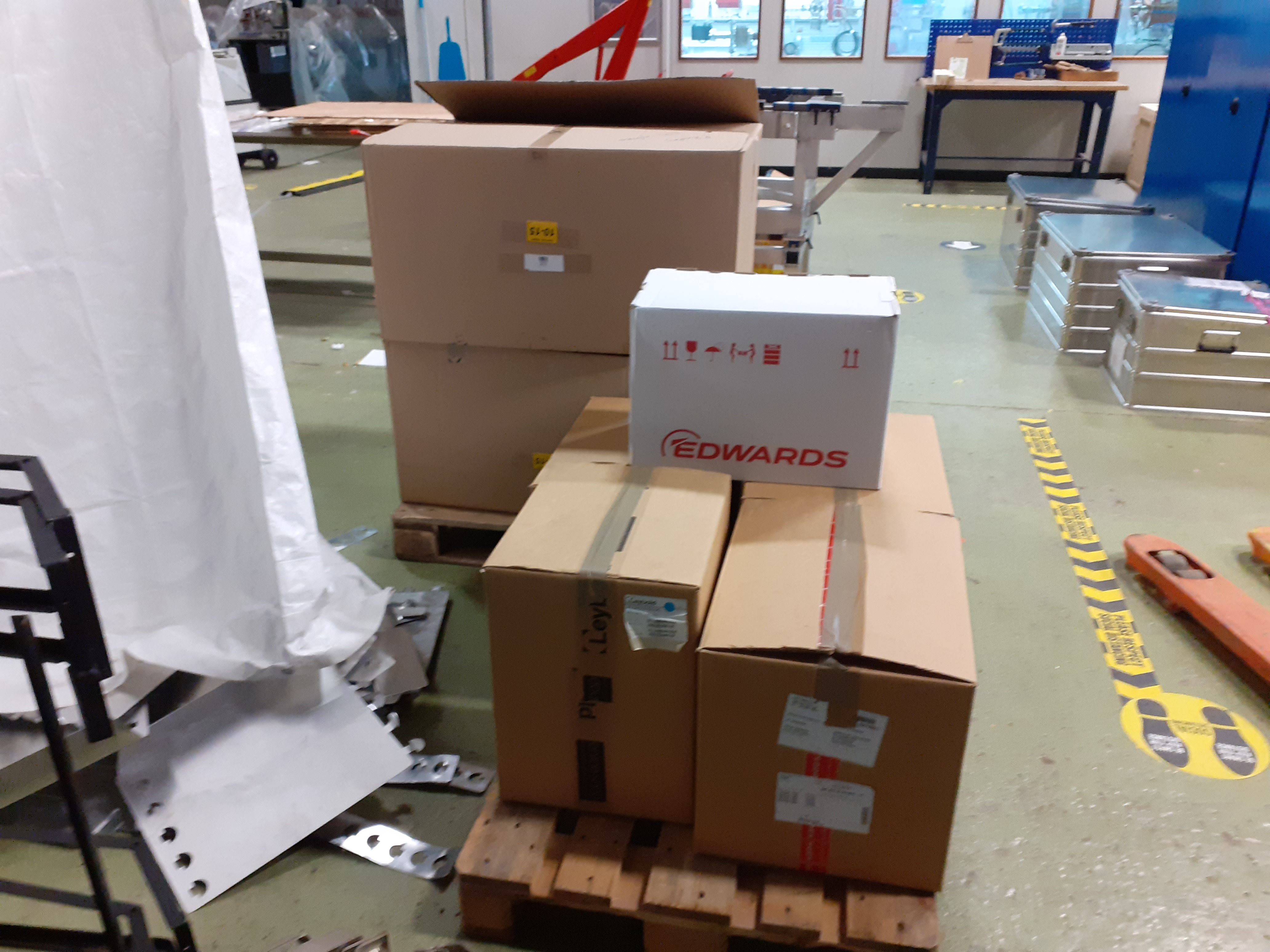
|
| Attachment 2: 20201204_161400.jpg
|

|
| Attachment 3: 20201204_161354.jpg
|

|
| Attachment 4: 20201204_161348.jpg
|

|
| Attachment 5: 20201204_161340.jpg
|

|
| Attachment 6: 20201204_161313.jpg
|

|
| Attachment 7: 20201204_161259.jpg
|
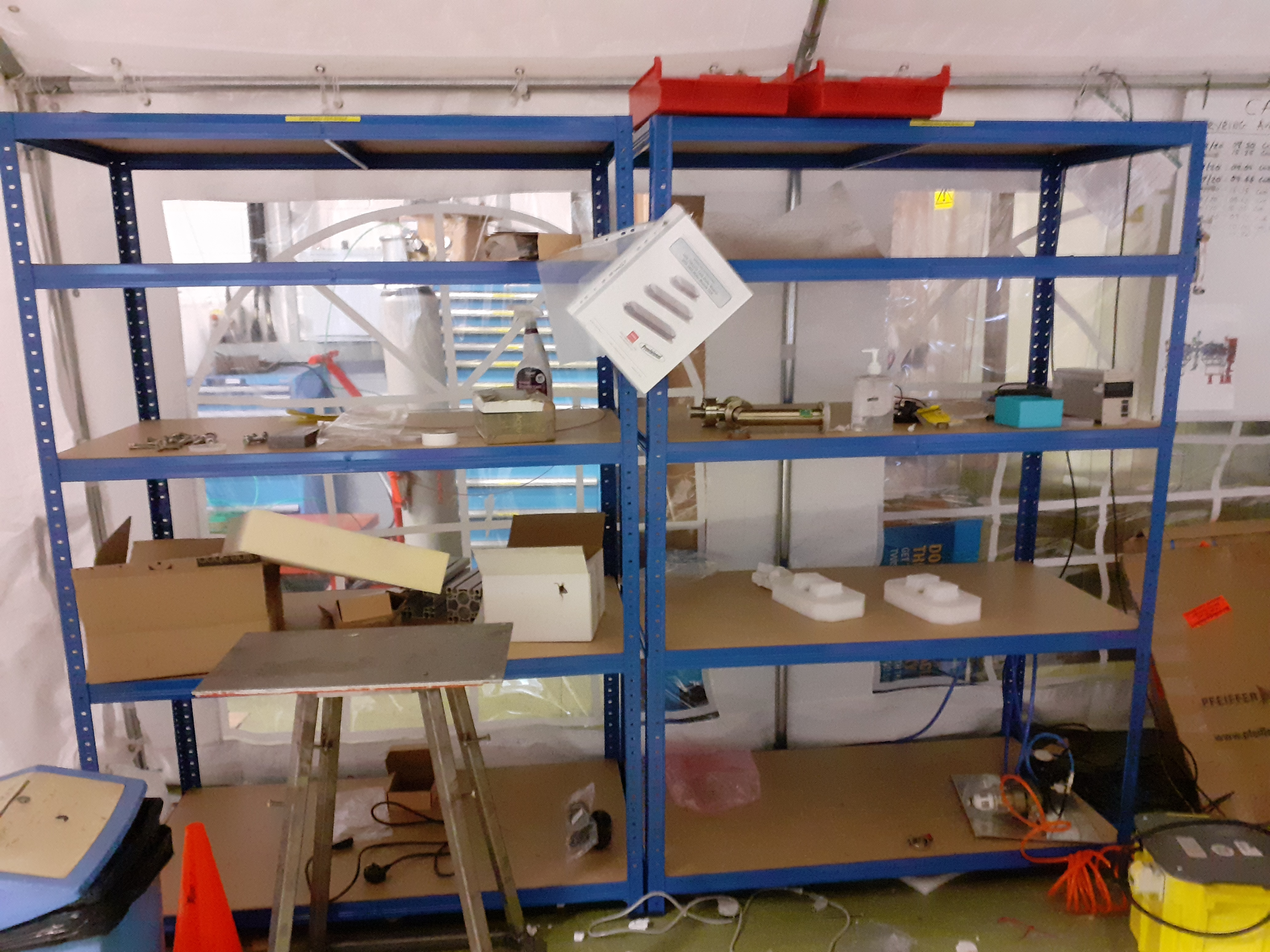
|
|
37
|
Mon Dec 7 14:29:12 2020 |
JM | CARME packing up |
|
| Attachment 1: 20201207_122353.jpg
|
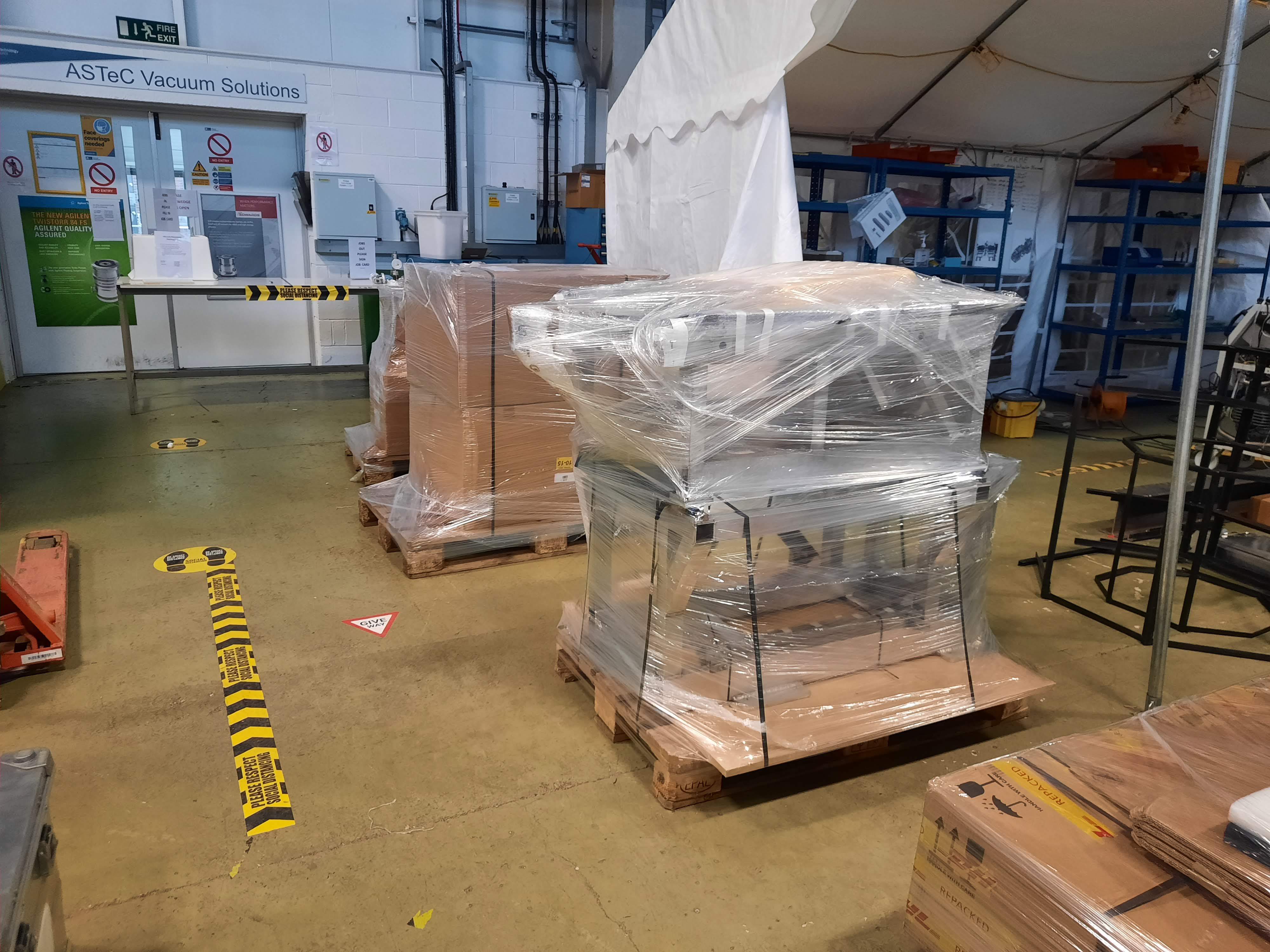
|
| Attachment 2: 20201207_113905.jpg
|

|
| Attachment 3: 20201207_110714.jpg
|

|
|
38
|
Mon Aug 9 12:36:00 2021 |
TD, RSS, ABD | Monday 9 August |
Attachments 1-5 - CARME shipment in CRYRING hall
XHV chambers nearest to YR09
Will remove top and sides of XHV chamber crate and install 4x SAES D-2000, 1x Leybold Mag Lev 400 turbo and 1x Leybold Ionvac IE514 gauge for basic vacuum test.
Attachments 6-7 - spare wire seals shipped from Edinburgh to GSI
poor packing and/or re-packing has resulted in bending of wire seals
wire seals shipped from STFC DL to GSI appear to be OK - see attachment 1
|
| Attachment 1: 20210809_132802.jpg
|

|
| Attachment 2: 20210809_132813.jpg
|

|
| Attachment 3: 20210809_132903.jpg
|

|
| Attachment 4: 20210809_132913.jpg
|

|
| Attachment 5: 20210809_133438.jpg
|

|
| Attachment 6: 20210809_145826.jpg
|
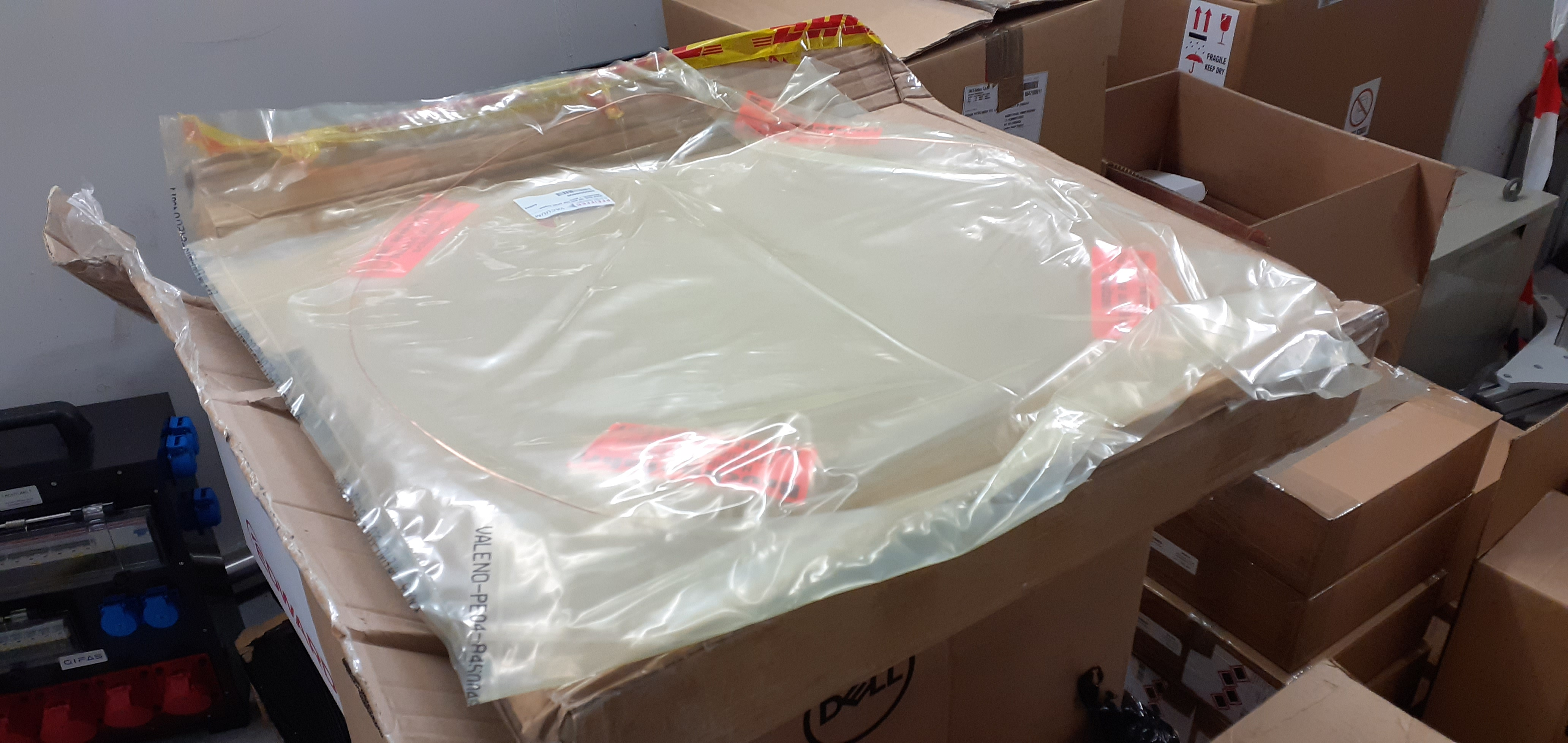
|
| Attachment 7: 20210809_145831.jpg
|
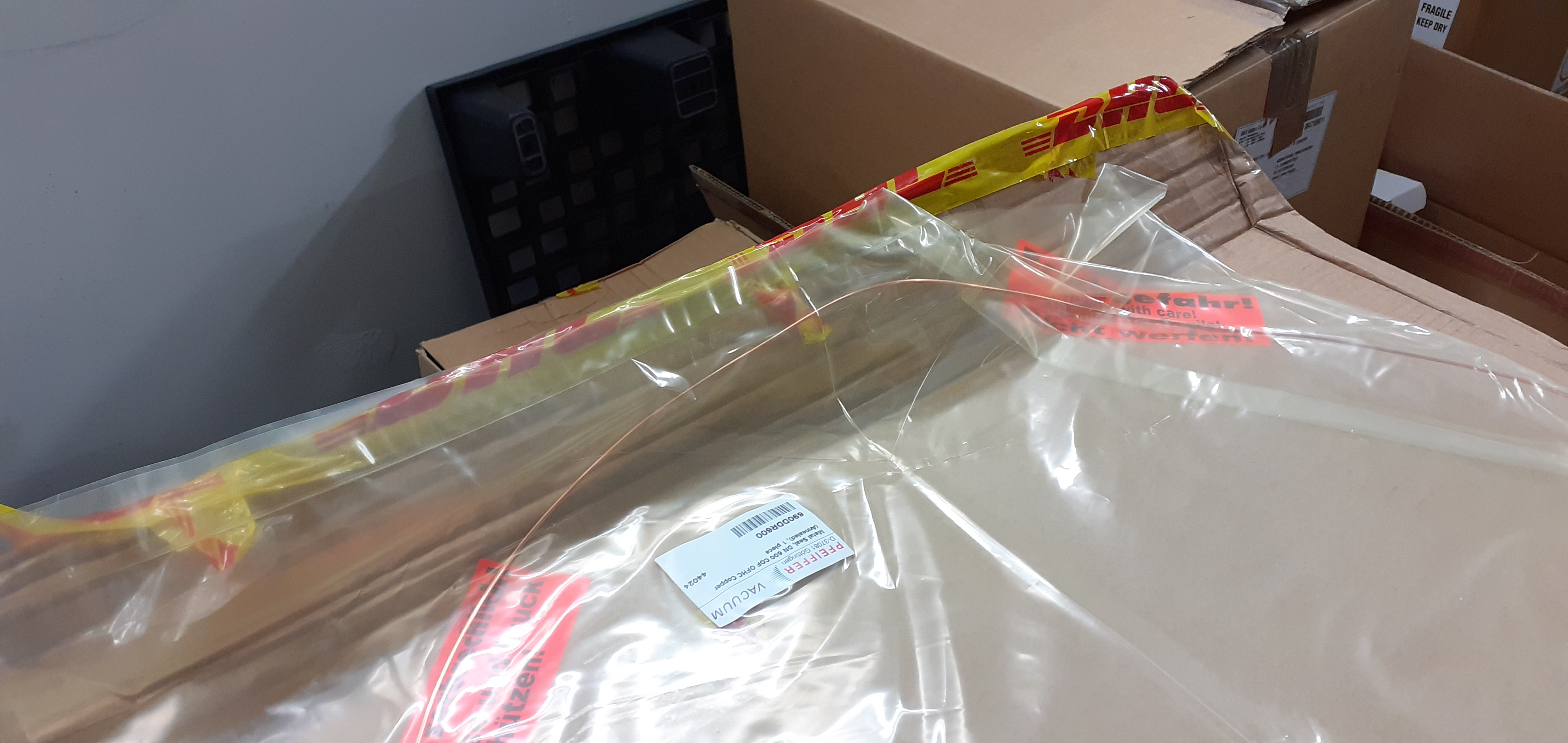
|
|
39
|
Tue Aug 10 12:22:56 2021 |
TD RSS | Tuesday 10 August |
Attachments 1-3 - 2 of 4 SAES D2000 installed at same ports used for STFC DL XHV tests |
| Attachment 1: 20210810_115555.jpg
|

|
| Attachment 2: 20210810_115607.jpg
|
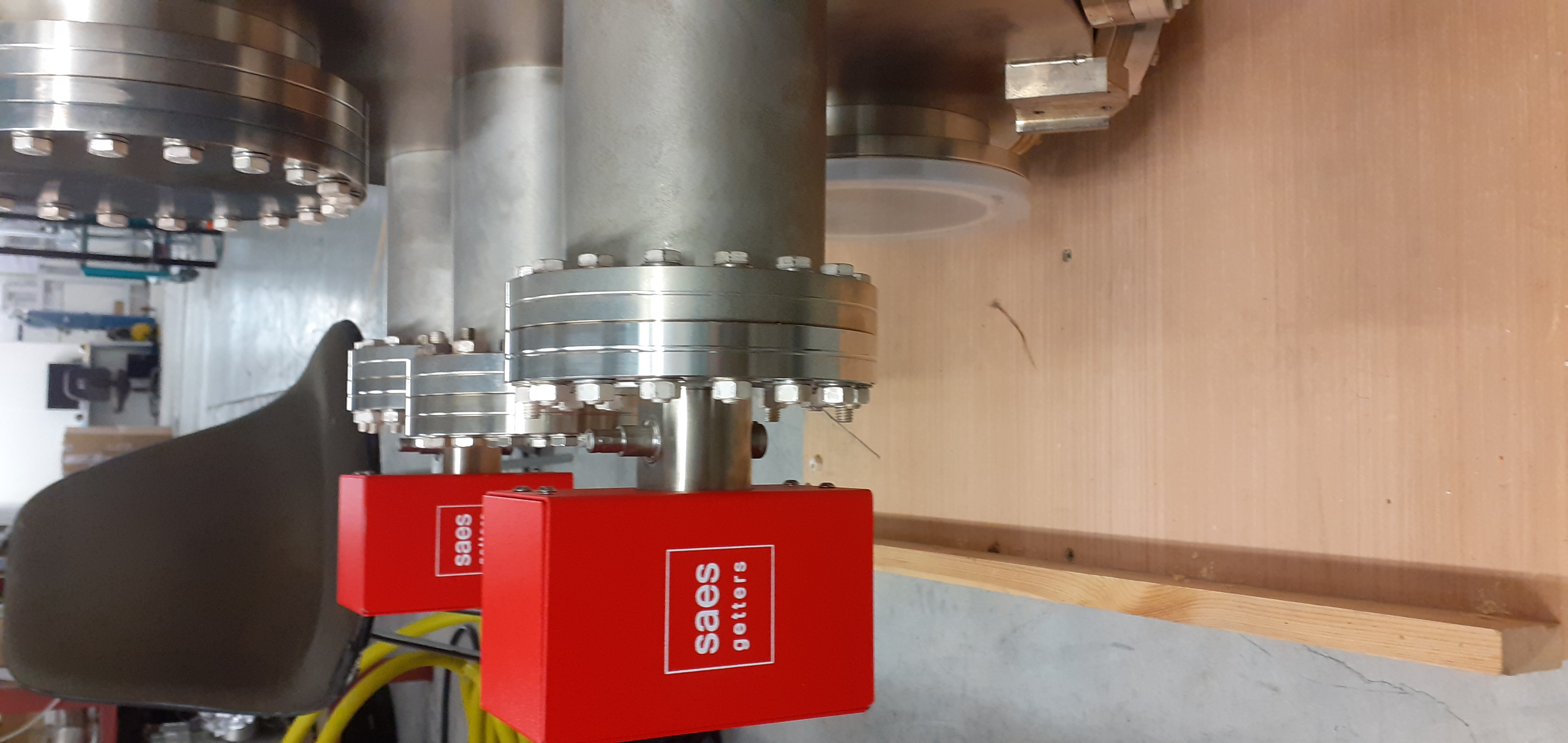
|
| Attachment 3: 20210810_115617.jpg
|

|
|
40
|
Wed Aug 11 12:30:40 2021 |
TD RSS | Wednesday 11 August |
Attachments 1 & 2 - 2x SAES D-2000 re-fitted to side ports
all 4x SAES D-2000 now re-fitted to chamber
Will now fit 1x turbo and blank (currently) unused turbo port.
Attachments 3 & 4 - centre 2x78 pin micro-D feedthrough has some pins slightly bent - can probably be safely bent back into position
ALWAYS check 78-pin feedthroughs for bent/broken pins before fitting connectors/cabling
Attachment 5 - currently unused turbo port
Attachments 6 & 7 - turbo port from above and side
Attachment 8 - turbo + NW16/NW25 adaptor + NW25 s/s hose + scroll pump + turbo controller + CMS52 gauge controller
Note we currently do not have a vent valve or backing line vacuum gauge (both functions provided by leak detector at STFC DL). |
| Attachment 1: 20210811_132906.jpg
|

|
| Attachment 2: 20210811_132918.jpg
|
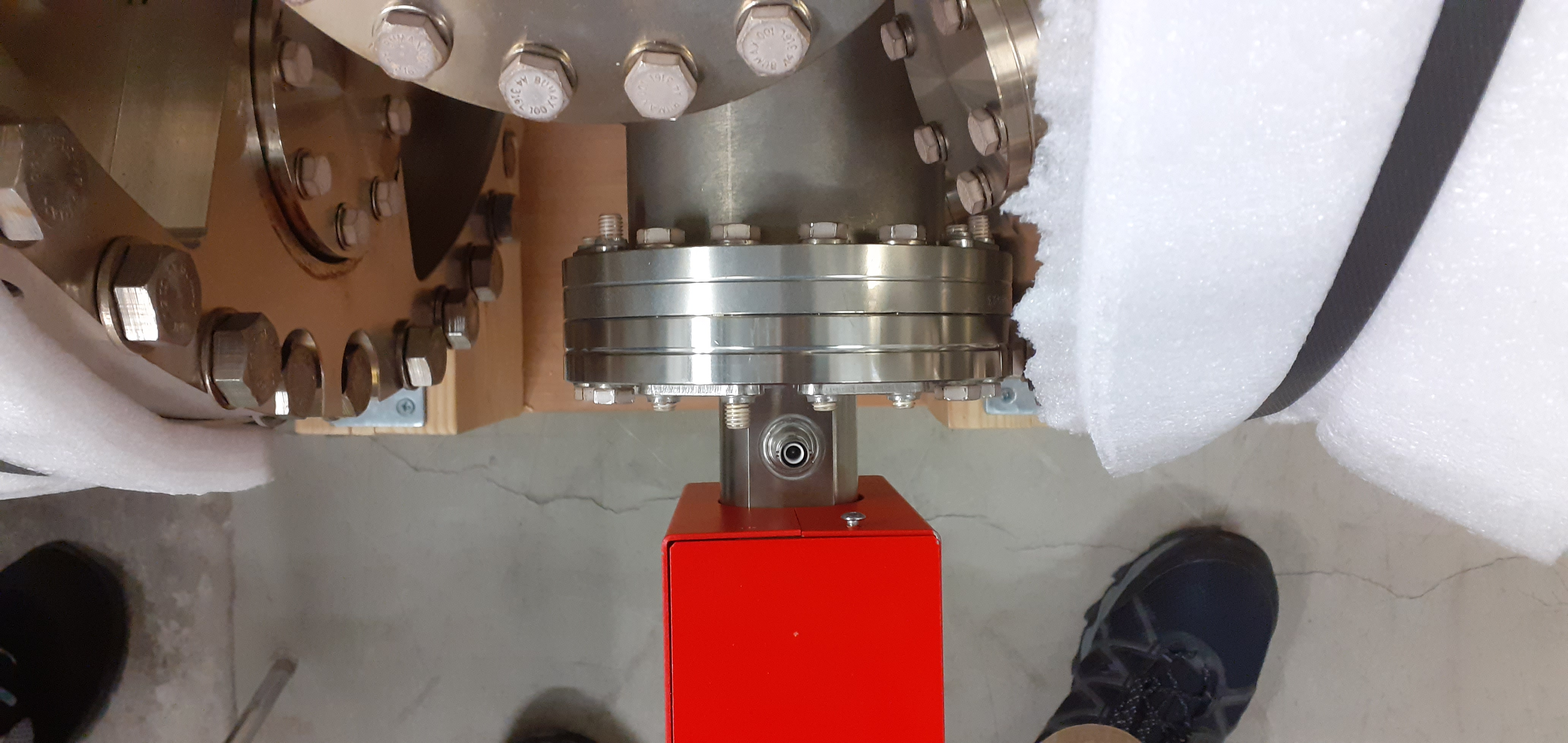
|
| Attachment 3: 20210811_132932.jpg
|
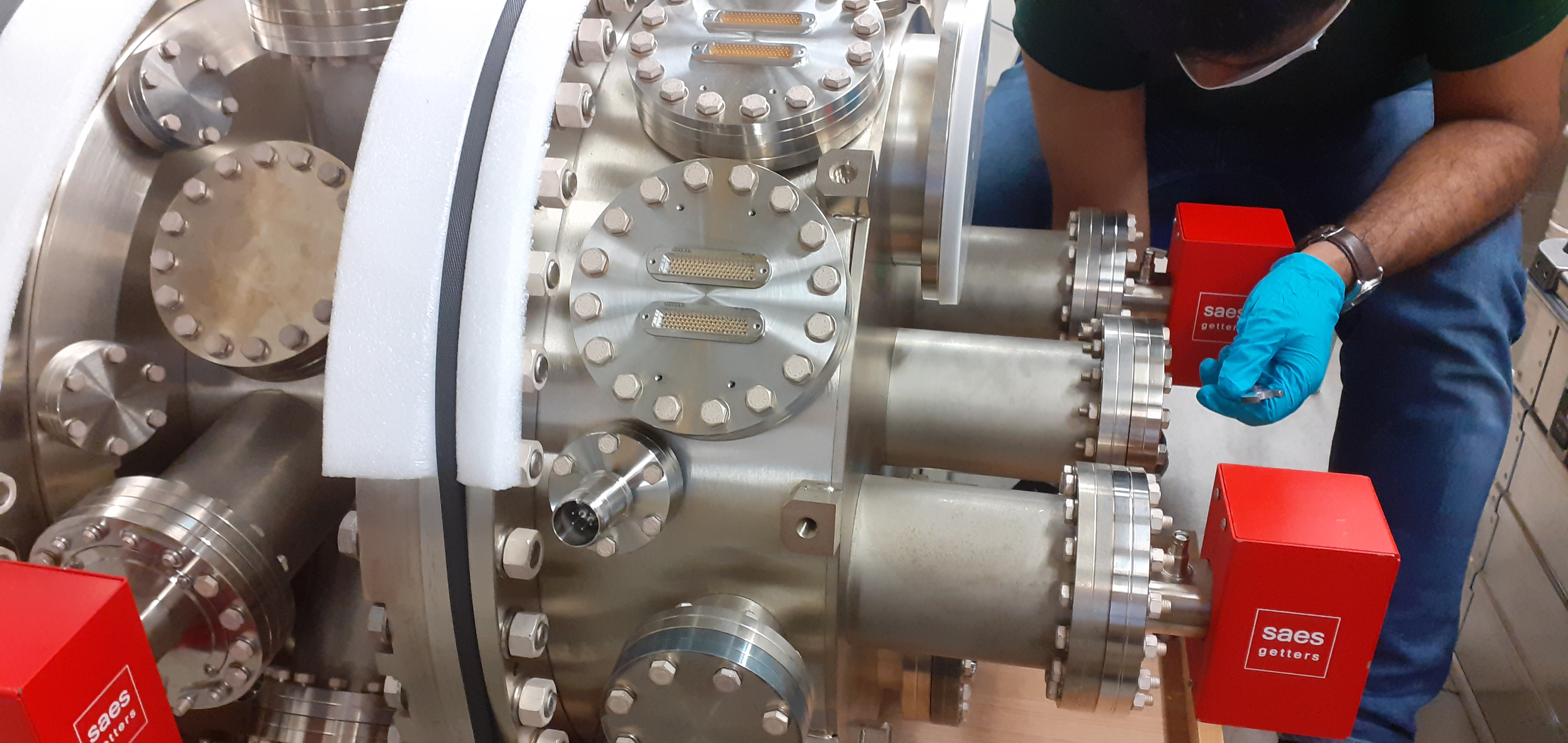
|
| Attachment 4: 20210811_132943.jpg
|

|
| Attachment 5: 20210811_142615.jpg
|

|
| Attachment 6: 20210811_142629.jpg
|

|
| Attachment 7: 20210811_142638.jpg
|
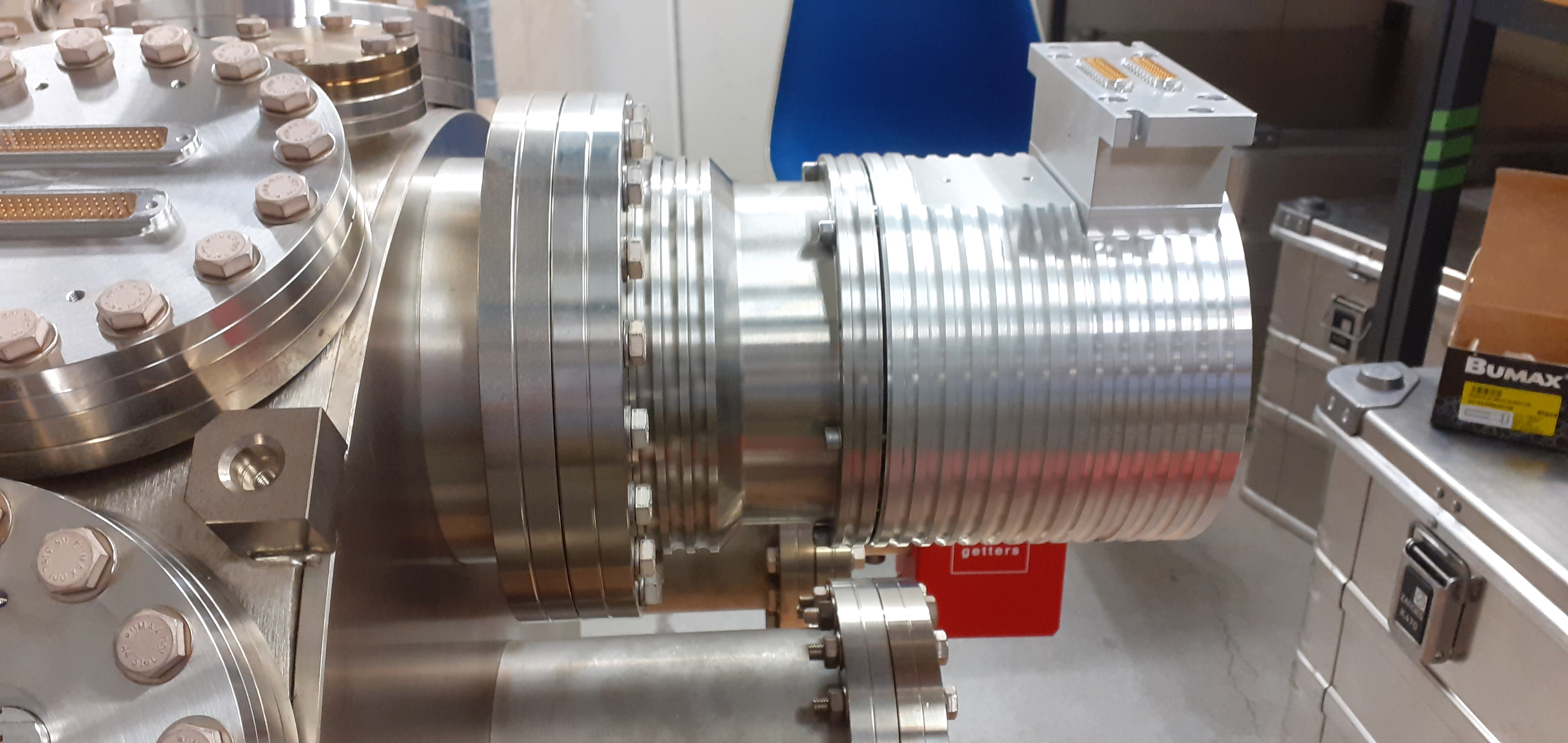
|
| Attachment 8: 20210811_153236.jpg
|

|